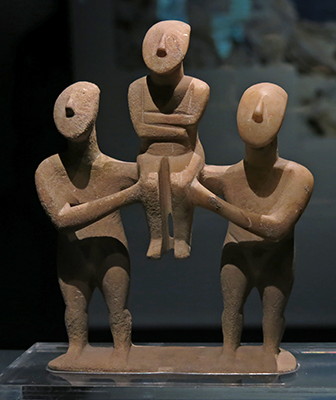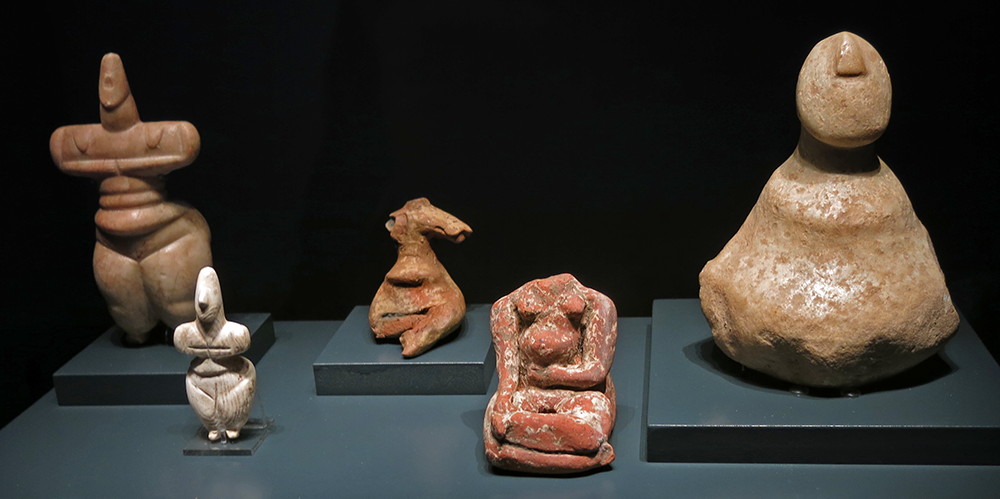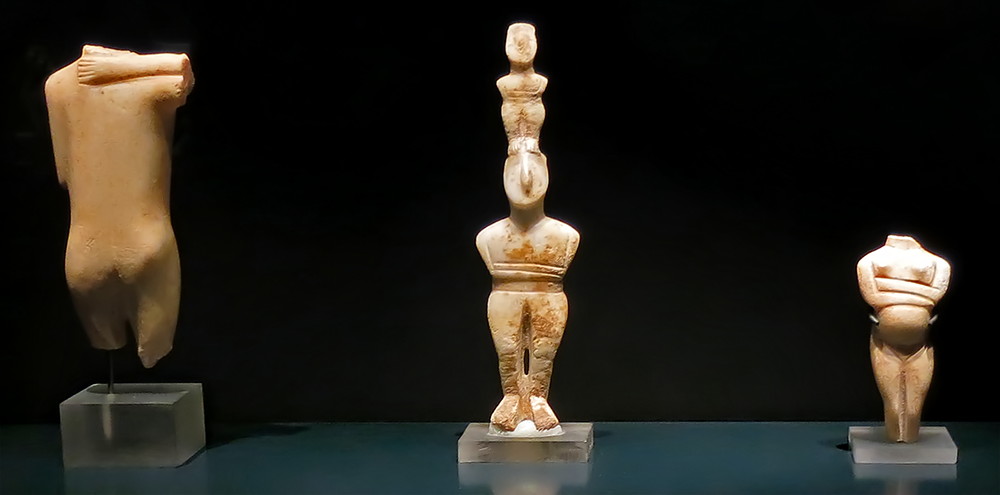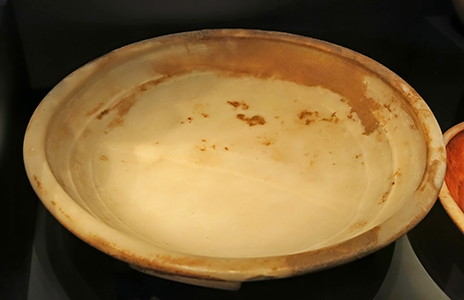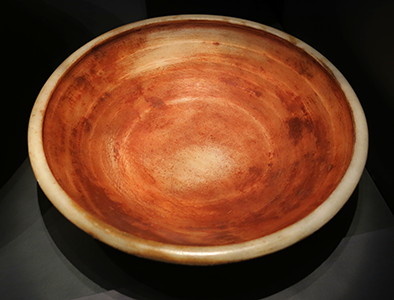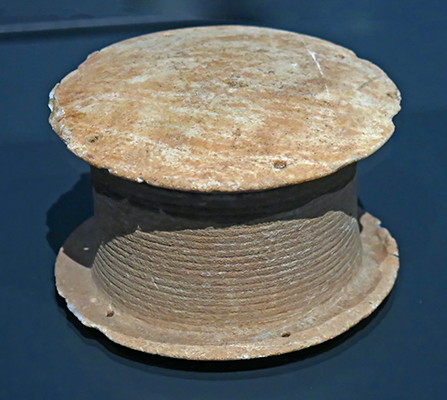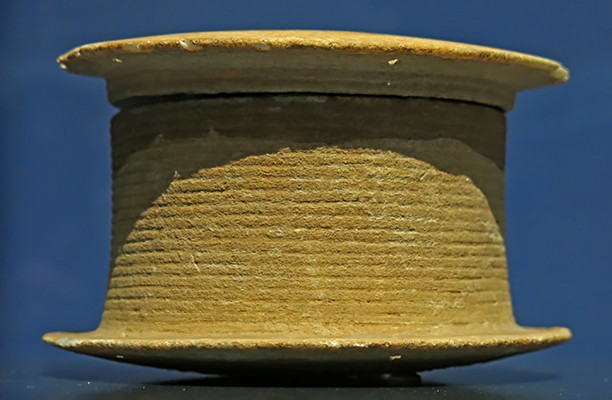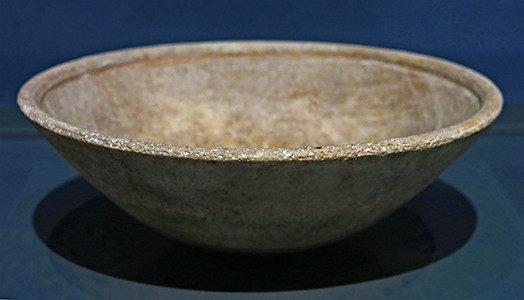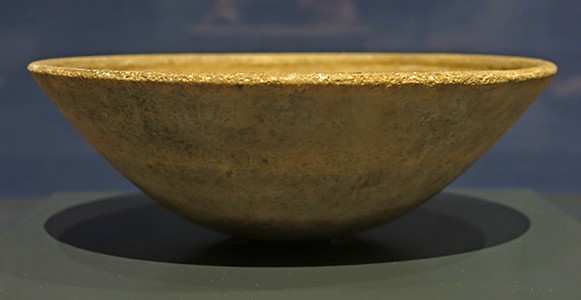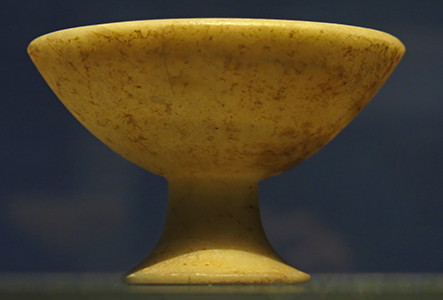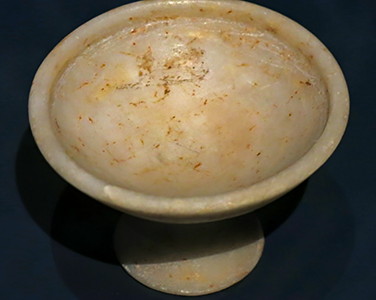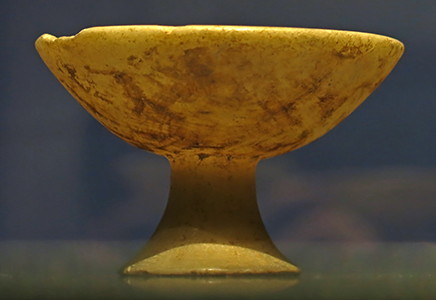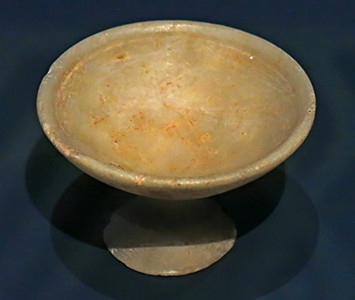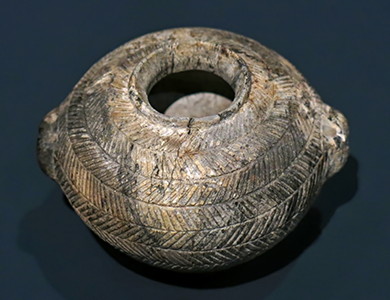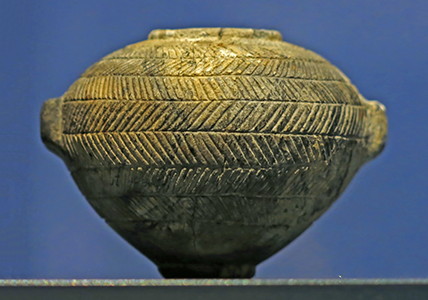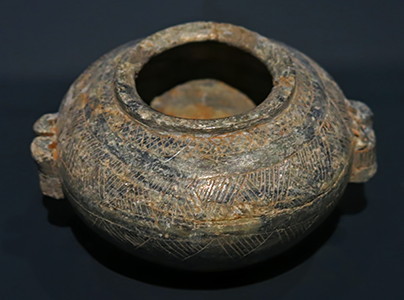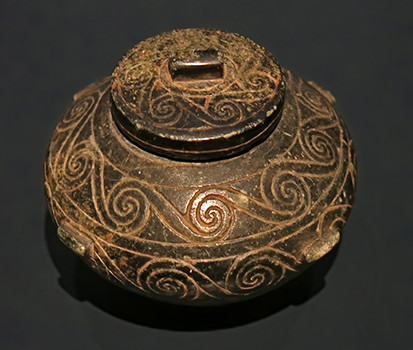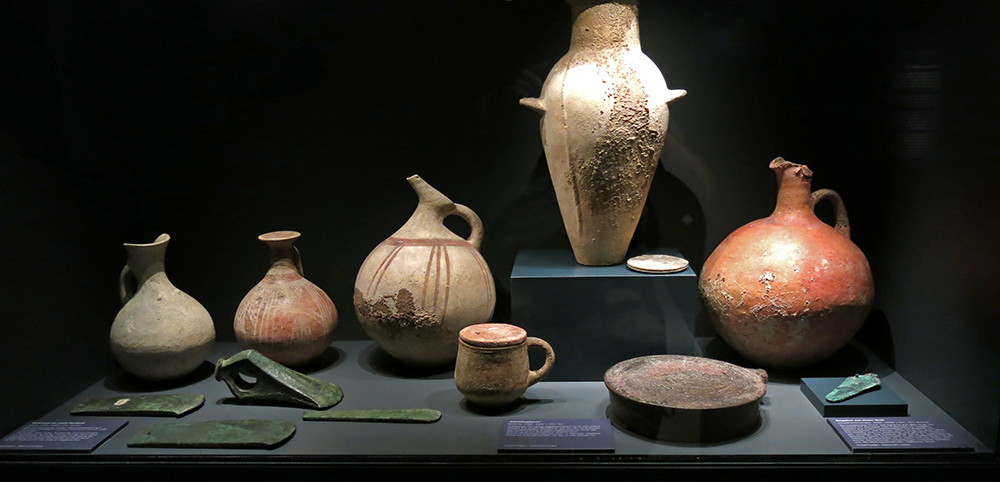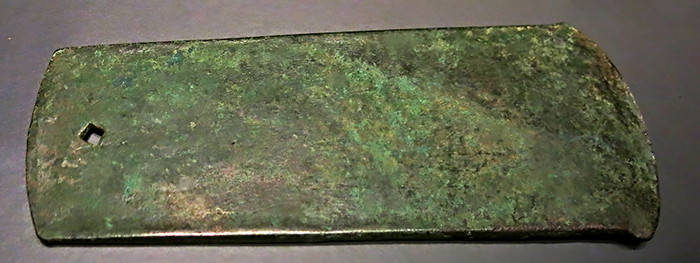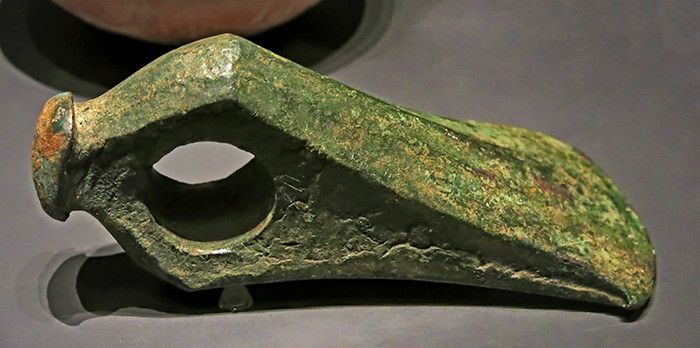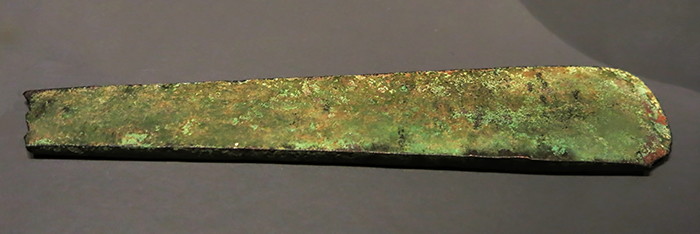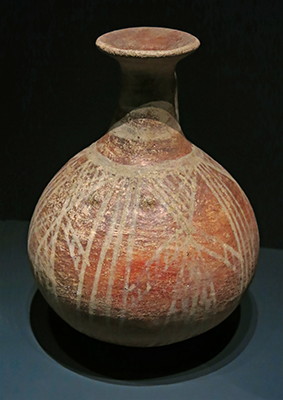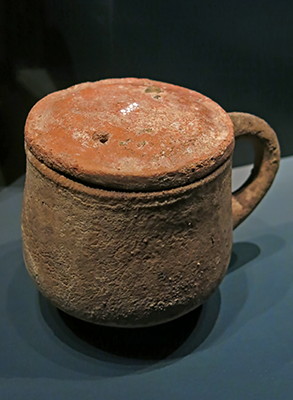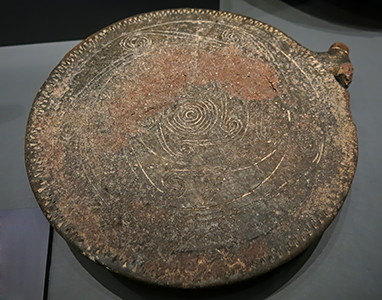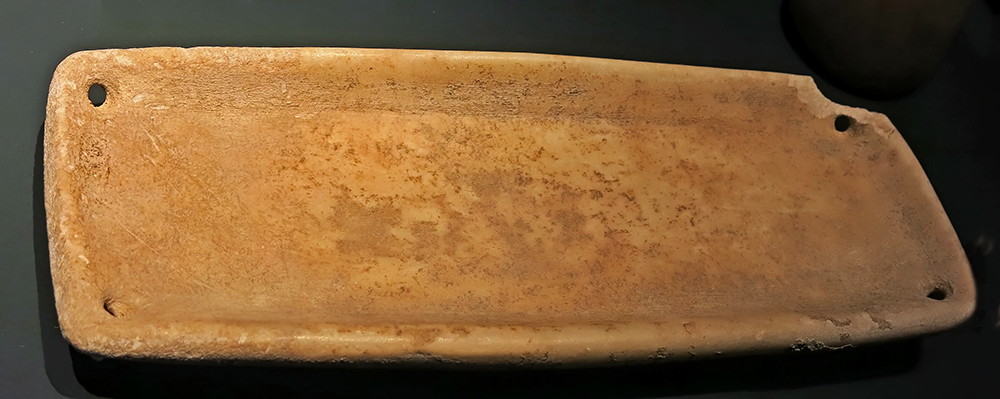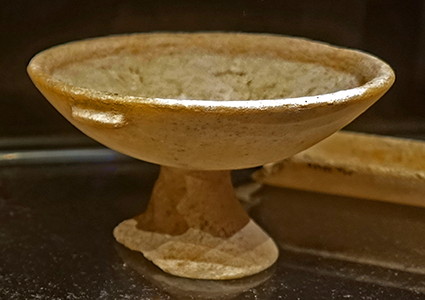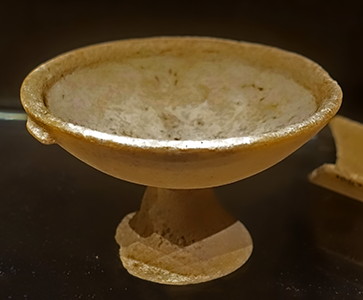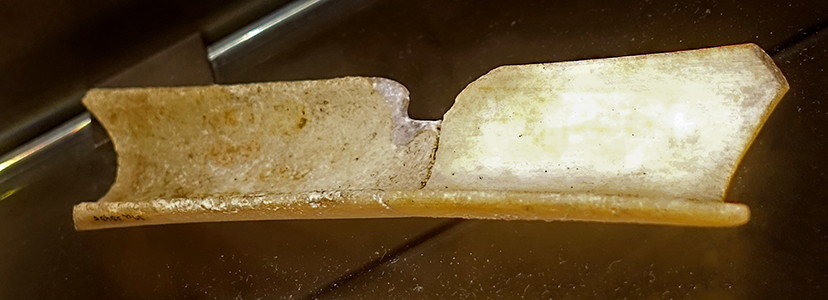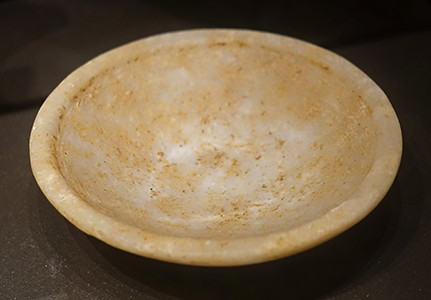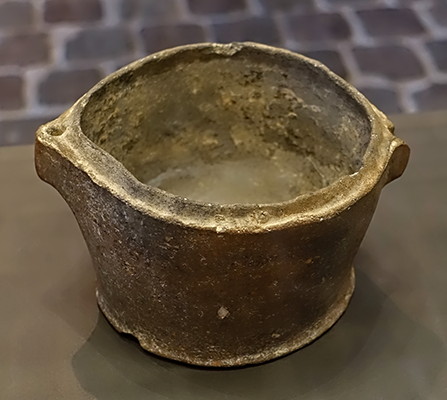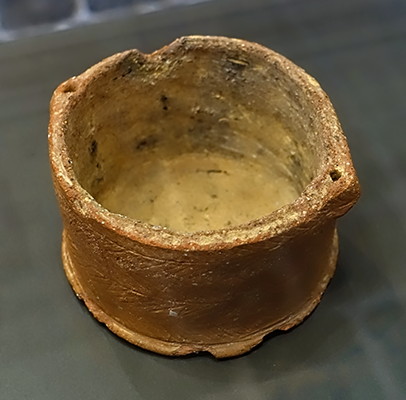Back to Don's Maps
 Back to Archaeological Sites
Back to Archaeological Sites
Cyclades Art
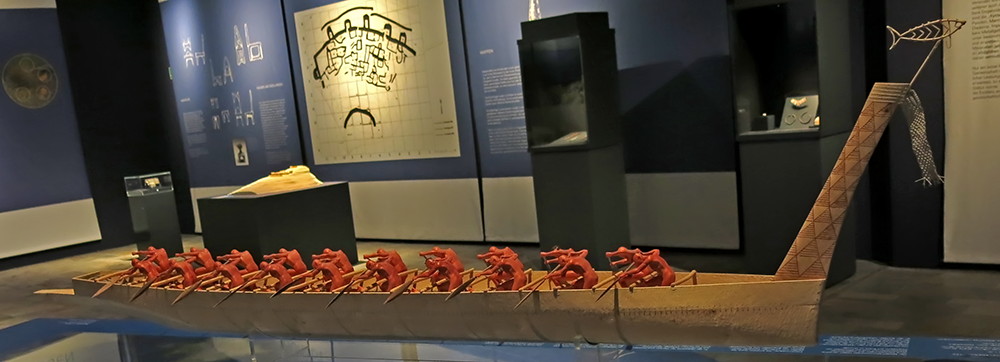
Model boat from the Cyclades
Photo: Don Hitchcock 2015
Artist: Dipl. Des. Thomas Guttandin, Hattersheim, 2011
Built for the exhibition 'Islands of the Winds' in the Archäologischen Institut Heidelberg
Source and text: Archäologische Staatssammlung München
Kykladen - Frühe Kunst in der Ägäis Exhibition in Archäologische Staatssammlung München There were 17 000 visitors to the exhibition 'Cyclades - Early Art in the Aegean' in 2015.
They flocked to see Early Bronze Age art on the Greek Cyclades Islands and its world-famous marble ambassadors, the 'Cycladic Idols'. The Munich public, school classes and visitors from abroad admired the diverse forms, the beauty and quality of this early small-scale sculpture.
Text above: Archäologische Staatssammlung München, press release 21. 7. 2015
( Personal note: this is by far the best single exhibition I have ever seen. The quality of the entire 'Cyclades - Early Art in the Aegean' display was stunning. My congratulations to all concerned. - Don )
Credits
Idea and scientific conception: Dr. Katarina Horst
Project leader: Prof. Dr. Rupert Gebhard, Dr. Harald Schulze
Exhibition architecture and graphic design: Ranger Design, Stuttgart
Texts: Dr. Katarina Horst, Dr. Harald Schulze, Dr. Bernhard Steinmann
Traineeship: Dr. Bettina Braunmüller
Booklet: Dr. Harald Schulze, Renate Wehdanner
Public Relations: Dr. Andrea Lorentzen
Restoration: Peter Albert, Egon Blumenau, Cristina Mazzola, Shimon Mahnke
Building services: Dragan Gvosdanovic, Michael Kaschner, Robert Plank, Andreas Söll
Multimedia: Christoph Stählin
Photos: Stefanie Friedrich
Cooperation partner: Badisches Landesmuseum Karlsruhe
Exhibits lent by:
Berlin, Staatlichen Museen, Antikensammlung
Bonn, Akademisches Kunstmuseum
Hamburg, Museum für Kunst und Gewerbe
Heidelberg, Antikenmuseum der Universität
Karlsruhe, Badisches Landesmuseum
Kopenhagen, Nationalmuseet
München, Museum Reich der Kristalle Mineralogische Staatssammlung
Würzburg, Martin von Wagner Museum
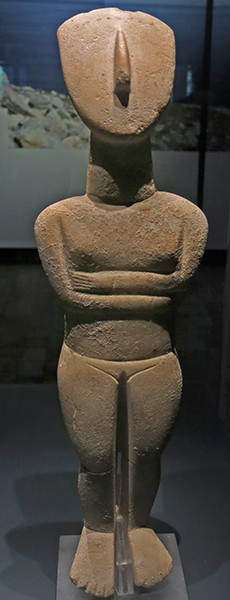
Large Cyclades Idol
2 700 BC - 2 400 BC, marble
The 'Munich idol' is an outstanding specimen of the classical Cycladic idols.
On the slim female body is a long conical neck supporting a large lyre-shaped head. The arms are folded under the breasts. The feet are directed diagonally downwards. Anatomical details are indicated by scribe lines. Paint residues and traces of weathering bear witness to the former painting of the piece.
Photo: Don Hitchcock 2015
Source and text: Archäologische Staatssammlung München

Details of the face of the idol above, now all but invisible on the object, but discernible on close inspection.
Here are shown the eyes and eyebrows, rows of dots on the cheeks and forehead and a line of serpents on the left half of the face.
Photo: Don Hitchcock 2015
Artist: Unknown
Source and text: Archäologische Staatssammlung München
Group of cycladic idols
Circa 2 600 BC, marble
Two male figures raise a smaller female figure on their arms. This group has a special significance in the Cycladic art: it is the only completely preserved composition of this kind. It is not certain whether it is meant to portray a divine triad, a mythological group, or a ritual performed in a religious festival.
Height 190 mm, width 154 mm, depth 37 mm, early Spedos type, Keros-Syros culture (EC II)
Photo: Don Hitchcock 2015, 2018
On loan from the Badisches Landesmuseum Karlsruhe, Catalog # K9, inv. 77/59
Source and text: Archäologische Staatssammlung München, Badisches Landesmuseum Karlsruhe
Additional information: Wikipedia
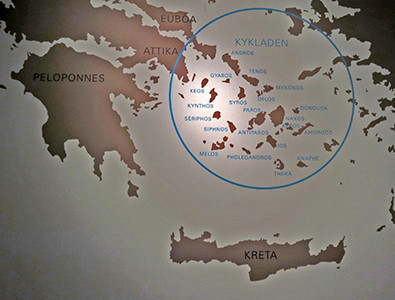
Map of the Cyclades Islands.
At the height of the last Ice Age, 20 000 BC - 18 000 BC, the sea level was about 120 metres below today's level. As a result, many Cyclades islands were part of a contiguous landmass. Only with the end of the ice age and the resultant rise of sea level did today's island world with its characteristic appearance emerge. The Cyclades are currently attractive mainly because of their Mediterranean climate with mild winters and hot, dry summers.
For prehistoric man undoubtedly other aspects were more important. Raw materials, such as, for example, various rocks, but also ores for metal extraction, added to the resources of the sea, contributed to the natural wealth of the Cyclades. The mountainous, densely wooded and low-lying landscape, having a rainfall of less than 400 mm per year, as well as having to accept the danger of crop losses due to periods of drought, made the islands rather unattractive for early agriculture.
Lined up like a string of pearls, the Cyclades islands lie in the blue waters of the Aegean Sea. A mild climate with constant winds and fertile soils on volcanic rocks formed the basis for the emergence of a highly developed culture at the transition from the Stone Age to the Bronze Age around 3 000 BC. Mineral resources formed the basis for technical development in the areas of stone processing, metal extraction and pottery. With seaworthy longboats, the islanders dtraded from the coast of Asia Minor to Crete and made their archipelago a hub for cultural contacts in the eastern Mediterranean. World-famous ambassadors of this Cycladic culture are the 'cycladic idols' made from the marble of the islands: the exhibition places the figures and the objects made of stone, metal and clay that they found together in the cultural contexts of research Island world, which enters into a dialogue with us over a period of 5 000 years.
Cartographer: Unknown
Photo: Don Hitchcock 2015
Source and text: Archäologische Staatssammlung München
Reconstruction of the Cycladic settlement of Kastri on the island of Syros.
The settlement is located on the summit of a 165 m high hill, steeply sloping on three sides. To the coast it is 310 m as the crow flies. The town is surrounded by a double wall, consisting of a rampart and a main wall with protruding bastions. A third wall ring protects the summit. Possibly this was a manorial seat. The settlement area, interrupted by small courtyards and squares, runs through an irregular lane. Estimates suggest that 100-300 people lived in this settlement, spread over several large families.
Fortified places such as Kastri were common in the second half of the Bronze Age. The expense of building the wall and the difficulties that life had on a mountain top were accepted because of an increased need for security. Despite these walls, however, Kastri was captured and destroyed by unknown conquerors.
Photo: Don Hitchcock 2015
Model by Dr Bernhard Steinmann
On loan from Badisches Landesmuseum Karlsruhe
Source and text: Archäologische Staatssammlung München
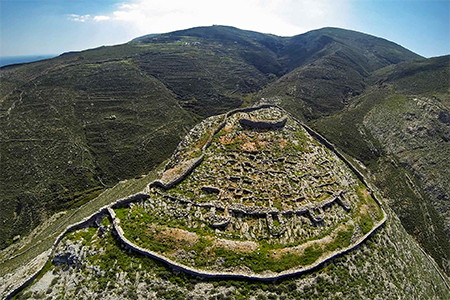
Kastri
At a distance of about 45 minutes from Chalandriani a prehistoric settlement from the later years of the Early Cycladic period II was discovered covering an area of 3.5 to 5 acres. In this area excavations brought to light a graveyard with about 600 tombs as well as ruins of inestimable value that revealed items of ceramic, stone and metalwork.
Various vases, jewellery and household items were also found during the excavations in the region indicating that this was a highly developed settlement. The two archaeological sites of Chalandriani & Kastri are linked with a long and rough path.
Photo: https://www.syrosisland.gr/en/place/kastri/
Source and text: https://www.syrosisland.gr/en/place/kastri/
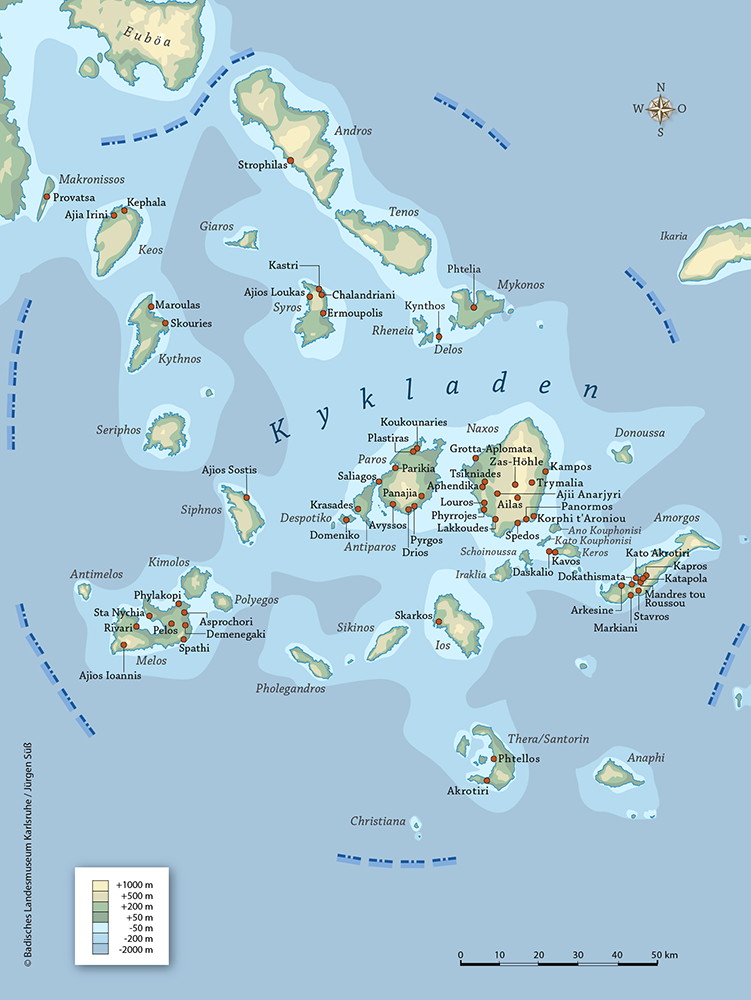
Map of the Cyclades, showing the important sites.
Photo: Pressekonferenz (2011)
Group of figures, treated in detail below.
Photo: Don Hitchcock 2015
Source: Archäologische Staatssammlung München

Neolithic idol, 4th millennium BC, marble
Marble idol of a standing woman with abdominal bulges and extremely bulging buttocks. Broad shoulders and angled arms form a rectangular shape. The widely spaced breasts are indicated as flat lobes. On the broad neck sits a stylised small head.
Photo: Don Hitchcock 2015
Source and text: Archäologische Staatssammlung München
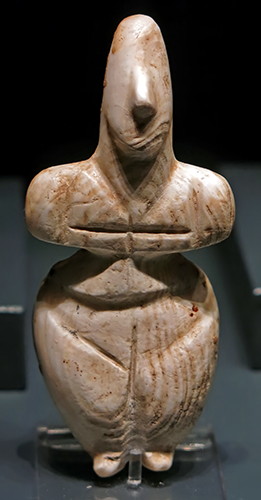
Neolithic idol, 4th millennium BC, calcite.
This Aegina calcite statuette has a polished surface. Because of the material, the shape is more schematic than the marble figures.
Aegina is one of the Saronic Islands of Greece in the Saronic Gulf, 27 kilometres from Athens.
Photo: Don Hitchcock 2015
Source and text: Archäologische Staatssammlung München
On loan from: München, Staatliche Antikensammlungen und Glyptothek
Additional text: Wikipedia
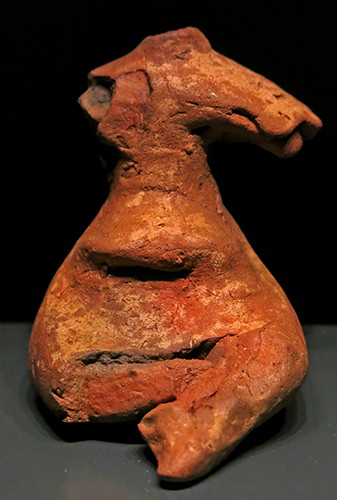
Neolithic idol, 4th millennium BC, clay.
Sitting Neolithic clay Idol from Northern Greece.
As well as in the Balkans and Asia Minor, such idols were widespread in northern Greece.
Photo: Don Hitchcock 2015
Source and text: Archäologische Staatssammlung München
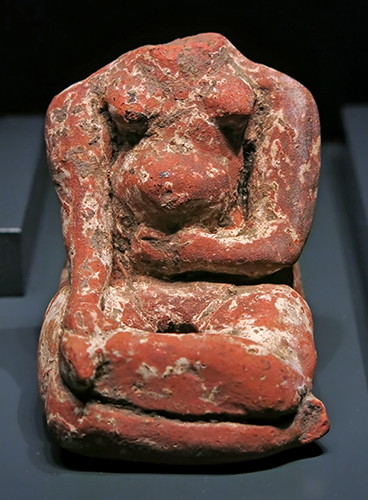
Neolithic idol, 4th millennium BC, clay.
The sitting posture is here well defined, with folded legs. A hand is placed protectively under the pregnant belly.
Photo: Don Hitchcock 2015
Source and text: Archäologische Staatssammlung München
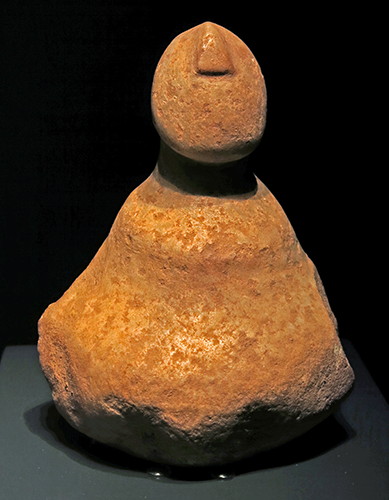
Cyclades idol.
2 900 BC - 2 700 BC, marble.
A unique sitting Cycladic idol with superimposed arms and legs.
The Neolithic type of seated woman with crossed legs did not prevail in the expression of the Cycladic idols. An experiment was evidently this unfinished 'blank' of a very early Cycladic idol which shows a figure in the 'Stone Age cross-legged' pose, and with the arms under the breasts.
This type dating back to Stone Age motifs did not prevail in the form of the classical Cycladic idols which followed.
The artists further abstracted this concept in the Cycladic culture by their idols, which limit the body to a flat outline.
( note, however, that this example shows the classic nose and flat face which survived in the portrayal of the classic idols which followed - Don )
Photo: Don Hitchcock 2015
Source and text: Archäologische Staatssammlung München
Additional text: Horst et al. (2015)
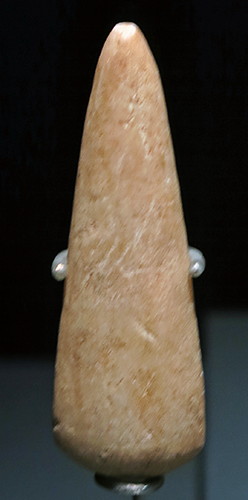
Neolithic idol.
4th Century BC, marble.
This Stone Age idol has been reduced to the abstract shape of a pointed conical outline.
In its radical reduction to such a simple form, such an object is comparable to objects of modern art.
Photo: Don Hitchcock 2015
Source and text: Archäologische Staatssammlung München
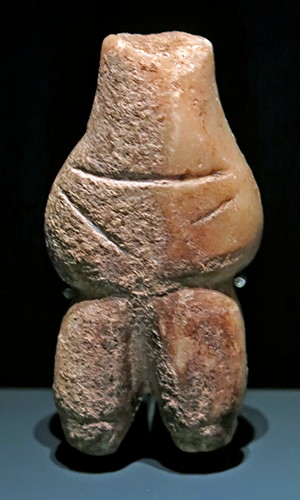
Neolithic idol.
4th Century BC, marble.
This late Neolithic marble idol has reduced the body to the stomach, lower body and legs.
Photo: Don Hitchcock 2015
Source and text: Archäologische Staatssammlung München
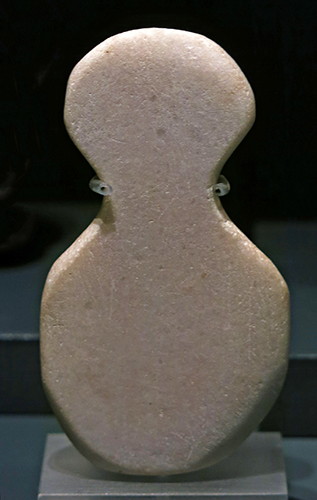
Cyclades idol
3 200 BC - 2 900 BC, marble.
This type of figure-eight shaped figurine is sometimes referred to as a yarn winder.
They are related to figures from Asia Minor, for example from Troy, and are rather rare in the Cyclades.
Photo: Don Hitchcock 2015
On loan from Bonn Akademisches Kunstmuseum
Source and text: Archäologische Staatssammlung München
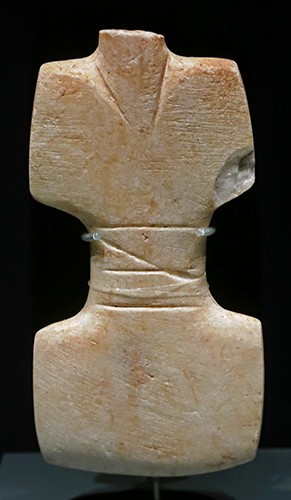
Cyclades idol
3 200 BC - 2 900 BC, marble.
The angular contour distinguishes this idol from other violin idols. The grooves at the waist indicate abdominal folds or a belt. The presentation of such details is rather rare for figurines of this type.
Photo: Don Hitchcock 2015
On loan from Martin von Wagner Museum, University of Würzburg
Source and text: Archäologische Staatssammlung München
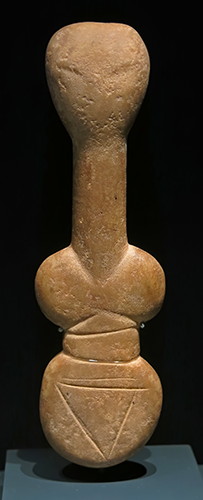
Cyclades idol
3 200 BC - 2 900 BC, marble.
Experimental hybrid of a violin idol with a long neck and head.
Characteristic details of the female body such as a pubic triangle, abdominal folds and arms are indicated by scribe lines.
Photo: Don Hitchcock 2015
Source and text: Archäologische Staatssammlung München
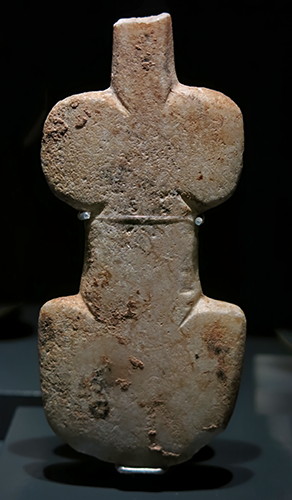
Cyclades idol
3 200 BC - 2 900 BC, marble.
The violin-shaped figurine has a rounded outline. Neck, chest and hips are accented by slight nicks. The sculpture is broken at the neck.
Photo: Don Hitchcock 2015
On loan from Martin von Wagner Museum, University of Würzburg
Source and text: Archäologische Staatssammlung München
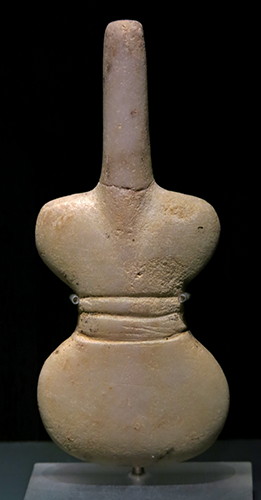
Cyclades idol
3 200 BC - 2 900 BC, marble.
This violin-shaped idol has an overlong, strongly stylised neck and head area.
At the waist, scribe lines presumably indicate abdominal wrinkles and folded arms.
Photo: Don Hitchcock 2015
On loan from Badisches Landesmuseum Karlsruhe
Source and text: Archäologische Staatssammlung München
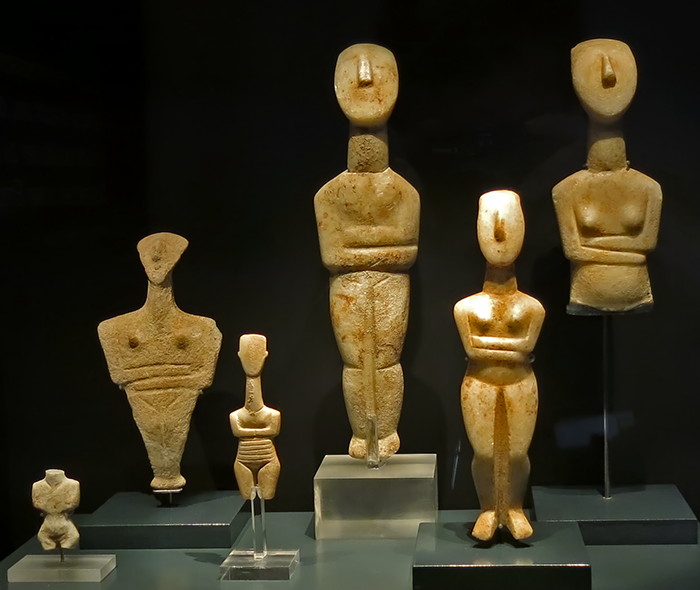
Classical forms
Classic Cycladic Idols developed from an interplay of naturalistic and abstract forms.
They reference stone age idols, but reduce their bulky physicality and use a number of stylised protocols. The canonical figure shows a standing naked woman with arms crossed under her breasts. These idols are subdivided into subtypes that co-existed during the golden age of Cycladic culture, due to certain design features.
The group of figures displayed here are treated in detail below.
Photo: Don Hitchcock 2015
On loan from Badisches Landesmuseum Karlsruhe
Source and text: Archäologische Staatssammlung München

Cyclades idol
3 200 BC - 2 900 BC, marble.
The hands lying above the abdomen assign the torso of this female idol to the Plastiras type. The neck and the area below the pelvis were broken in ancient times.
Figurines of the 'Plastiras' type, named after the cemetery on Paros where they were first identified, were contemporary with violin-shaped figurines and represent the earliest attempt at the naturalistic rendering of the human figure in the third millennium BC. These figurines, which are mainly female and of small dimensions (h. 7-31 cm.), display some of those features that were subsequently to develop into distinctive traits of Cycladic figurines, such as the position of the arms below the breasts and the ovoid head with a nose in relief.
However, the sculptors had not yet conquered the abstraction of the mature period of Cycladic art and instead cleaved to a markedly naturalistic conception, which is particularly pronounced in the treatment of the pelvic area, the pubic triangle and the legs. Typologically, the Plastiras type figurines are a development of the steatopygous figures of the Late Neolithic period, 5 300 BC - 3 200 BC.
Photo: Don Hitchcock 2015
On loan from Bonn Akademisches Kunstmuseum
Source and text: Archäologische Staatssammlung München
Additional text: © Museum of Cycladic Art, https://cycladic.gr/en/exhibit/ng1111-ginaikio-idolio-tipou-plastira
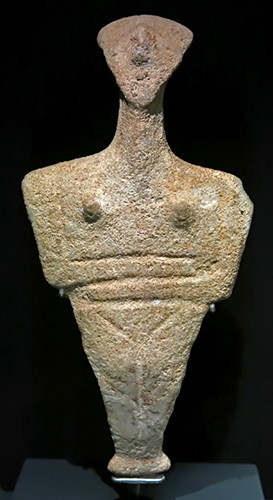
Cyclades idol
2 700 BC - 2 400 BC, marble.
This flat triangular idol with broad shoulders is a representative of the Chalandriani type. Only the nose, the wide-set breasts and the buttocks are modelled.
The Chalandriani variety is a type of Cycladic figure from the end of the Early Cycladic II period of the Bronze Age. Named for the cemetery on the island of Syros on which they were found, these figures are somewhat similar in style and mannerism to the Dokathismata variety that preceded them. Chalandriani figures, however, feature a more truncated shape in which the arms are very close to the pubic triangle and the leg cleft is only indicated by a shallow groove.
One feature of note with the Chalandriani variety is that the strict right-below-left configuration found in previous figures seemed to have relaxed, as some sculptures have reversed arms or even abandonment of the folded position for one or both arms. The reclining position of previous figures is also challenged, as the feet are not always inclined and the legs are somewhat rigid. The shoulders were expanded even further from the Dokathismata variety and were quite susceptible to damage as the upper arms and shoulders are also the thinnest point of the sculpture. The head is triangular or shield-shaped with few facial features other than a prominent nose, connected to the body by a pyramidal-shaped neck. Like figures of the Dokathismata variety, some Chalandriani figures appear to be presented as pregnant. The defining feature of these figures is their bold and exaggerated indication of the shoulders and upper arms.
Photo: Don Hitchcock 2015
On loan from the Museum für Kunst und Gewerbe, Hamburg
Source and text: Archäologische Staatssammlung München
Additional text: Wikipedia
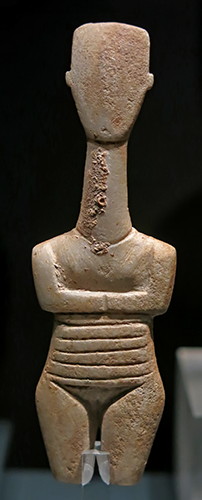
Cyclades idol
3 200 BC - 2 700 BC, marble.
This early hybrid form of an idol combines flatness of the figure with an overlong neck and a faceless head. Added to this is the emphasis on the Stone Age tradition of belly folds and the pubic triangle.
On loan from: München, Staatliche Antikensammlungen und Glyptothek
Photo: Don Hitchcock 2015
Source and text: Archäologische Staatssammlung München
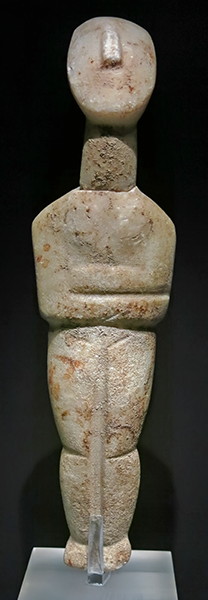
Cyclades idol
2 700 BC - 2 400 BC, marble.
Typical idol of the most common Spedos type. The elongated head sits on a long neck. The legs are joined, with an exterior dividing line to the feet. The arms block the upper body.
Text below from Wikipedia:
The Spedos type, named after an Early Cycladic cemetery on Naxos, is the most common of Cycladic figurine types. It has the widest distribution within the Cyclades as well as elsewhere, and the greatest longevity. The group as a whole includes figurines ranging in height from miniature examples of 8 cm to monumental sculptures of 150 cm. With the exception of a statue of a male figure, now in the Museum of Cycladic Art Collection, all known works of the Spedos variety are female figures. Spedos figurines are typically slender elongated female forms with folded arms. They are characterised by U-shaped heads and a deeply incised cleft between the legs.
Munchen, State Antiques Collections and Glyptothek
On loan from: München, Staatliche Antikensammlungen und Glyptothek
Photo: Don Hitchcock 2015
Source and text: Archäologische Staatssammlung München
Additional information: Wikipedia
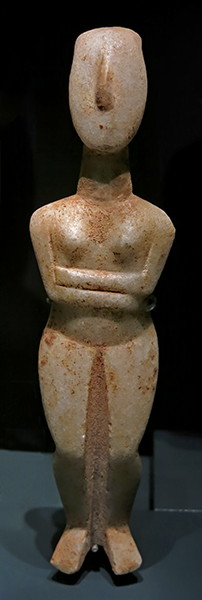
Cyclades idol
2 700 BC - 2 400 BC, marble.
This fully preserved figure of a female Cycladic idol belongs to the early Spedos type.
The head with Lyre-shaped outline is slightly tilted.
( this tilted aspect can be more clearly seen in the group photograph above - Don )
Photo: Don Hitchcock 2015
Source and text: Archäologische Staatssammlung München
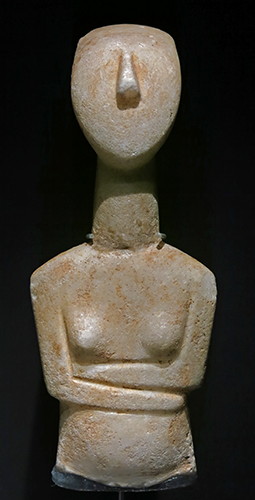
Cyclades idol
2 700 BC - 2 400 BC, marble.
This idol belongs to the Kapsala variety, which is known from the excavation contexts of Naxos, Amorgos, and Antiparos. The piece was purchased by archaeologist Robert Zahn in 1900 as the top of a naked female primitive marble figure in Athens.
Text below from Wikipedia:
The Kapsala variety is a type of Cycladic figure of the Early Cycladic II period. This variety is often thought to precede or overlap in period with that of the canonical Spedos variety of figures. Kapsala figures differ with the canonical type in that the arms are held much lower in the right-below-left folded configuration and the faces lack sculpted features other than the nose and occasionally ears.
Kapsala figures show a tendency towards slenderness, especially in the legs, which are much longer and lack the powerful musculature suggested in earlier forms of the sculptures. The shoulders and hips are much narrower as well, and the figures themselves are very small in size, rarely larger than 30cm in length. Evidence suggests that paint is now regularly used to demarcate features such as the eyes and pubic triangle, rather than carving them directly. One characteristic of note of the Kapsala variety is that some figures seem to suggest pregnancy, featuring bulging stomachs with lines drawn across the abdomen. Like other figures of the Early Cycladic II period, the most defining feature of the Kapsala variety is their folded-arm position.
Photo: Don Hitchcock 2015
On loan from Antikenmuseum der Universität Heidelberg
Source and text: Archäologische Staatssammlung München
Additional text: Wikipedia

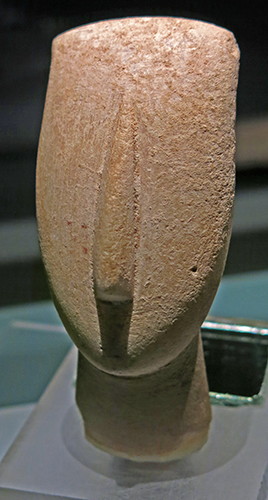
Cyclades idol
Keros, 2 700 BC - 2 400 BC, marble.
Very high quality head of a 40 cm high idol of the Spedos type. On the cheeks and chin red coloured dots may be made out. Furthermore, on the left side of the head, three curls of hairstyle, also painted, were obtained as weathering relief. Parts of the main hair or head covering are also still visible.
( I would presume that 'weathering relief' in this instance means that the paint protected the surface from erosion and weathering, and thus the decorations, or their original shape and placement, may be discerned - Don )
Photo: Don Hitchcock 2015
On loan from Karlsruhe Badisches Landesmuseum
Source and text: Archäologische Staatssammlung München
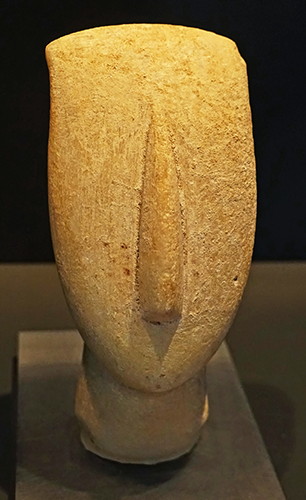
Cyclades head of an idol
Keros, 2 700 BC - 2 400 BC, marble.
Another photo of this important object, above, this time from its home in Karlsruhe after its return from the München exhibition.
Remains of painted rosette patterns and hair are still visible on the face.
Catalog: Inv. 70/550
Photo: Don Hitchcock 2018
Source and text: Karlsruhe Badisches Landesmuseum
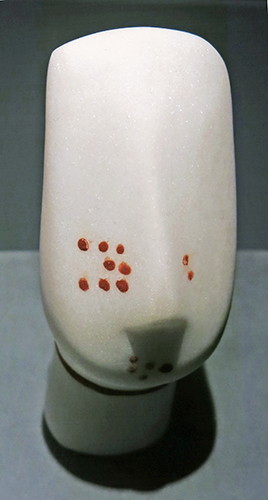
Painted head of a Cycladic idol
2011, marble
This colour-coordinated marble copy of the head of a Cycladic idol from the island of Keros shows the remaining evidence of the antique painting on the original which is shown immediately above.
Photo: Don Hitchcock 2015
On loan from Karlsruhe Badisches Landesmuseum
Source and text: Archäologische Staatssammlung München
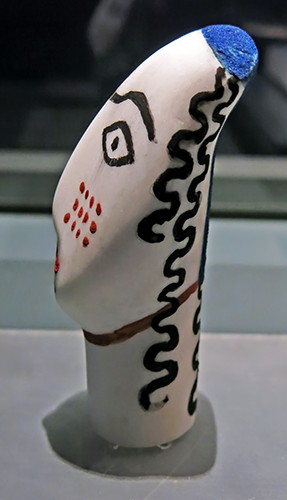
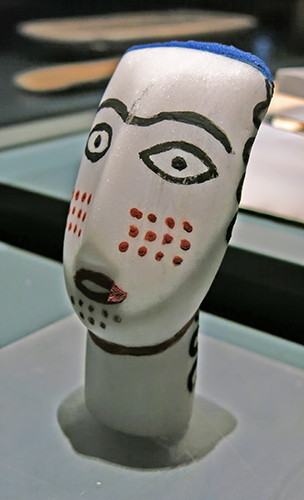
Painted head of a Cycladic idol
2011, marble
This coloured, modern marble head illustrates the standard painting of a head from the island of Keros. The cloth cap is painted with blue azurite, the eyes, eyebrows and the curls of the hairstyle are black. For the face painting, the mouth and the emphasised fold of skin on the neck are indicated with red cinnabar and reddish-brown ochre.
Photo: Don Hitchcock 2015
Artist: Unknown
On loan from Karlsruhe Badisches Landesmuseum
Source and text: Archäologische Staatssammlung München


Painted copy of a Cycladic idol
2011, artificial stone
(left) This copy of a large Cycladic idol was painted with the coloured pigments that were also used in the Cyclades in the 3rd millennium BC.
In this version, only the traces of the former painting still visible on the original were highlighted in colour.
(right) This complete reconstruction of the painting of the large Cycladic idol is based on observations of original and comparable Cycladic idols with preserved colour. The result gives a general impression of the original appearance of Cycladic idol sculpture.
Photo: Don Hitchcock 2015
Artist: Unknown
On loan from Karlsruhe Badisches Landesmuseum
Source and text: Archäologische Staatssammlung München
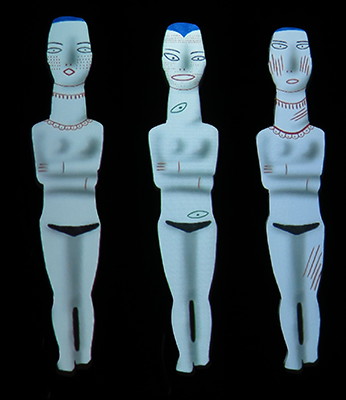
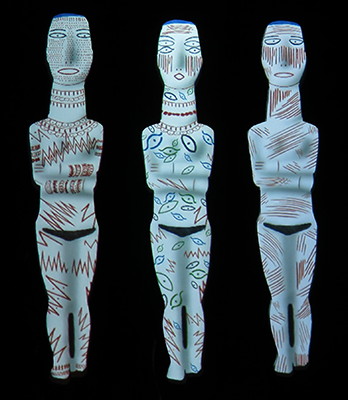
Painting of the idols
(left): Typical paintings on individual Cyclades Idols, with scattered markings apart from the eyes and mouth.
(right): The range of possible paintings, shown for brevity on individual Idols, although no one idol would have remotely so many markings. Note the different positions used for the painted eyes, shown on the centre representation on the right hand image.
Text above: Don Hitchcock
On closer examination of Cycladic idols traces of the former face and body painting are recognisable. Most of the time no colour is left, but formerly painted areas are still to be seen as weathering relief. In part, the colours used by the Cycladic people are also known: Blue from azurite and black from charcoal became accents of anatomical details such as eyes. They were used for eyebrows, hair and pubic triangles, or were used to indicate the headdress. Red haematite or cinnabar was used for jewelery, painting of the face and for body ornaments. Green malachite is rare, highlighting special decorative elements. Earth colours, reddish-brown or yellow ochre, were also well known. Almost all the minerals used in the painting were present in the Cyclades except for cinnabar.
Photo: Don Hitchcock 2015
Artist: Unknown
Source and text: Archäologische Staatssammlung München
Additional text: Don Hitchcock

Marble slab with colour samples, 2011
On this plate of Naxian marble, colours were applied that were available to the Cycladic dwellers such as azurite, haematite, cinnabar, ochre, malachite or charcoal. Various likely binders were tested in this series of tests and show a selection of possible colour shades.
Photo: Don Hitchcock 2015
Artist: Unknown
On loan from the Badisches Landesmuseum Karlsruhe
Source and text: Archäologische Staatssammlung München
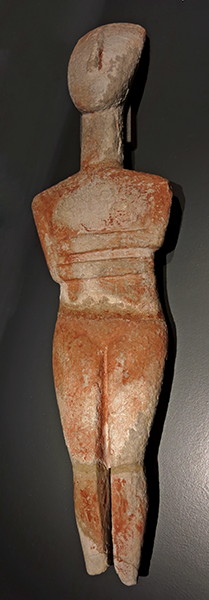
Cyclades idol
2 700 BC - 2 400 BC, marble.
This idol is made of grey marble in a very atypical way.
Upon completion of the sculpture, the figure was covered with a white layer of lime. In turn, a red ferruginous paint, probably haematite, was applied to this layer of lime.
Photo: Don Hitchcock 2015
On loan from the Badisches Landesmuseum Karlsruhe
Source and text: Archäologische Staatssammlung München

Cyclades Idol
2 700 BC - 2 400 BC, marble.
This very well-preserved female idol of the Spedos type is characterised by soft body shapes. The shoulders are narrow and round, the body is divided by deep indentations at the neck, groin, and feet sections. The oval head still shows the remains of red paint: a row of dots on the forehead and rows of dots on both sides of the nose.
Photo: Don Hitchcock 2015
On loan from: Staatlichen Museen zu Berlin Antikensammlung (Collection of Classical Antiquities)
Source and text: Archäologische Staatssammlung München

Cyclades Idol
2 700 BC - 2 400 BC, marble.
The plump head of this female figure flows smoothly into the extra-long neck. The sloping shoulders are comparatively rounded.
The lower abdomen is shown as slightly arched but is placed separately on the lower body with a flatter region below it, whereby the pubic area is emphasised.
Photo: Don Hitchcock 2015
On loan from: München, Staatliche Antikensammlungen und Glyptothek
Source and text: Archäologische Staatssammlung München
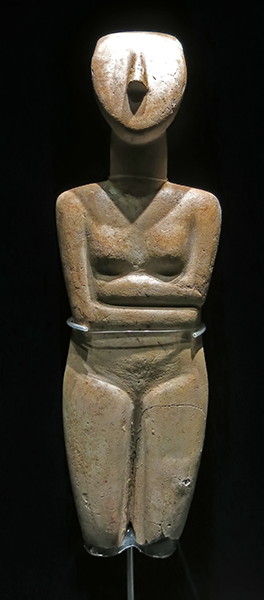
Cyclades Idol
Naxos, 2 700 BC - 2 400 BC, marble.
This slenderly proportioned idol has softly modelled body shapes. In a fire in 1945, the figure was damaged, so that the lower legs and feet are now missing. The nose tip was modelled from plaster.
Photo: Don Hitchcock 2015
On loan from Martin von Wagner Museum, University of Würzburg
Source and text: Archäologische Staatssammlung München
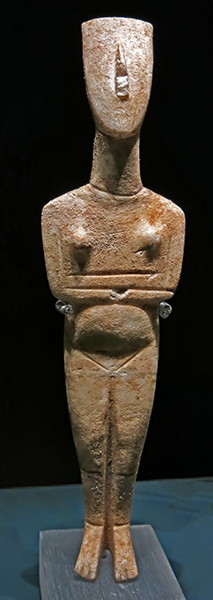
Cyclades Idol
Paros, 2 700 BC - 2 400 BC, marble.
This idol of the Spedos type shows typical features of this group such as the lyre-shaped head, the nature of the way the arms are indicated, the pubic triangle shown by scribed lines, and the notched toes.
Photo: Don Hitchcock 2015
On loan from Karlsruhe Badisches Landesmuseum
Source and text: Archäologische Staatssammlung München
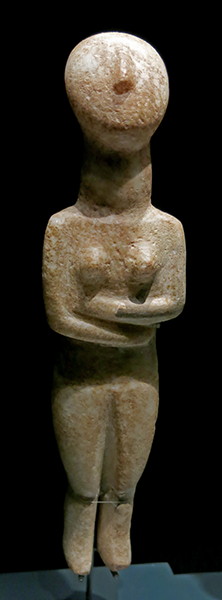
Cyclades Idol.
2 700 BC - 2 400 BC, marble.
Female idol of the Spedos type in an early variant with a broad neck and a rounded head shape.
Remains of red paint in the neck testify to the former painting. Interestingly, the idol was repaired in ancient times after one of the legs was broken.
Photo: Don Hitchcock 2015
On loan from the Museum für Kunst und Gewerbe Hamburg
(acquired with funds from the Campe'schen Historischen Kuststiftung)
Source and text: Archäologische Staatssammlung München
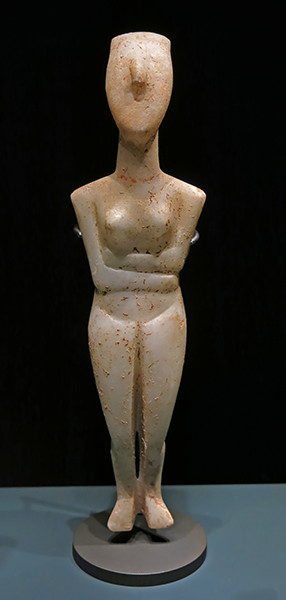
Cyclades Idol.
Paros, 2 700 BC - 2 400 BC, marble.
This female idol of the Spedos type has slender proportions and a lyre-shaped head.
At the neck can still be seen the remains of a painted necklace.
Photo: Don Hitchcock 2015
On loan from the Københavns Nationalmuseet
Source and text: Archäologische Staatssammlung München

Cyclades Idol.
Paros, 2 700 BC - 2 400 BC, marble.
This idol is a typical representative of the Kapsala type, so named after a necropolis on the island of Amorgos. Characteristically, the hips of this idol are quite full-bodied. Arms and shoulders, however, seem narrower. The slight buckling of the knees leads to a loosening of the straight posture.
Photo: Don Hitchcock 2015
On loan from: Hamburg, Museum für Kunst und Gewerbe
Source and text: Archäologische Staatssammlung München

Cyclades Idol.
Paros, 2 700 BC - 2 400 BC, marble.
This female idol of the Spedos type came from the possession of the archaeologist Thiersch which was by 1860 in the collection of the Grand Duke of Baden. The incised eyes are not antique and bear witness to the modern need to give facial features to the idol.
( ...and the modern addition of the incised eyes has been very poorly done! - Don )
Photo: Don Hitchcock 2015
On loan from: Karlsruhe Badisches Landesmuseum
Source and text: Archäologische Staatssammlung München
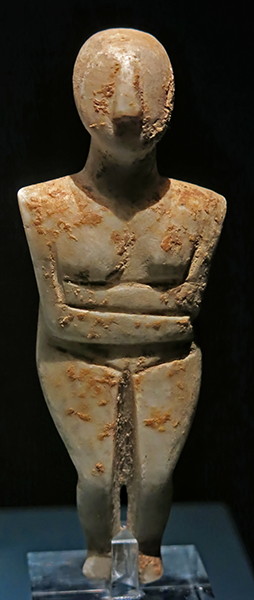
Cyclades Idol.
Paros, 2 700 BC - 2 400 BC, marble.
The stout neck of this idol is accompanied by unusually pointed shoulders. The legs are separated by a deep notch, which is broken at the level of the calves, and end in almost straight feet. From the shoulders downward, the curved contours of the figure taper to the tips of the feet.
On loan from: München, Staatliche Antikensammlungen und Glyptothek
Source and text: Archäologische Staatssammlung München
Musicians
Unique among the Cycladic idols and at the same time evidence of outstanding stone art sculpture are representations of musicians. They all belong to the group of male idols. Double-flute or panpipe players are always standing, harpists always sitting down.
A four-legged stool or a throne with backrest serves as seating. The motif of the throne points to an important meaning, but it is unclear whether they are divine beings, rulers, mythological figures or the depiction of certain customs during a feast or ceremony.
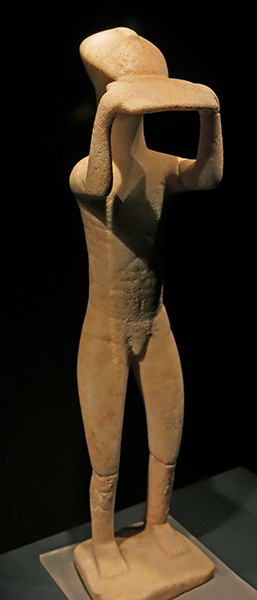
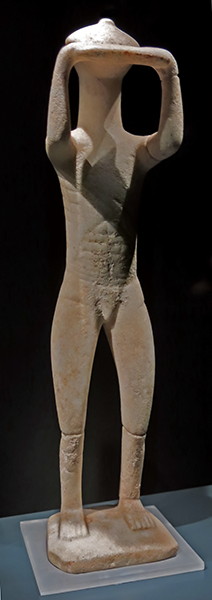
Pan Pipe player.
2 700 BC - 2 400 BC, marble.
This standing male marble figure of the Spedos type plays a wind instrument, the pan pipe or syrinx.
( This relatively simple, stylised sculpture of a fit young man also demonstrates the way that fine musicians go off into a world of their own, they forget their surroundings and simply make beautiful music - Don )
On loan from: Karlsruhe Badisches Landesmuseum
Source and text: Archäologische Staatssammlung München
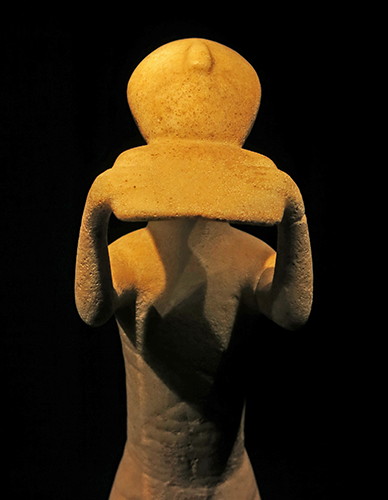
Pan Pipe player, close up.
2 700 BC - 2 400 BC, marble.
All Cyclades Culture musicians are men.
It is unclear whether this is a deity or the representation of a role of men in religious festivals.
On loan from: Karlsruhe Badisches Landesmuseum
Source and text: Archäologische Staatssammlung München
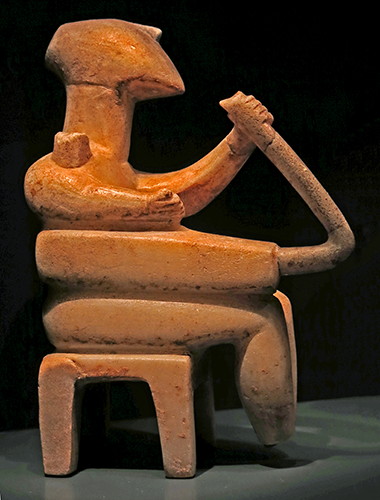
Harp player.
Thera, 2 700 BC - 2 400 BC, marble.
This pair of harp players, the second of which is shown immediately below, were added, along with three marble vessels from the Maler collection, into the Grand Ducal Collection in Karlsruhe in 1853. They are some of the earliest Cycladic objects known in Europe. Allegedly, the pieces were found along with four marble vessels in a grave on Thera.
On loan from: Karlsruhe Badisches Landesmuseum
Source and text: Archäologische Staatssammlung München
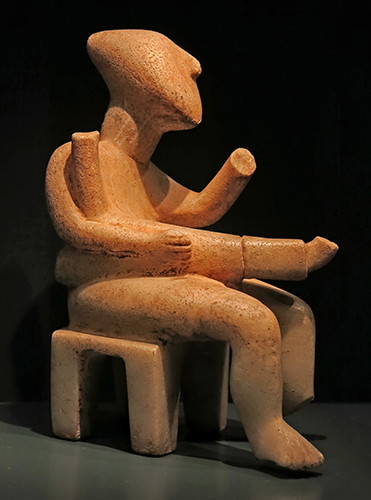
Harp player.
Thera, 2 700 BC - 2 400 BC, marble.
Harp player
Thera, 2700 2400, marble
The artist managed to break up the rigid composition by placing the musical instrument diagonally across the lap of the harpist.
The head is slightly inclined to the instrument. This gives the figure additional dynamics.
The limbs testify to the rounded forms and soft transition of an excellent elaboration by the artist.
On loan from: Karlsruhe Badisches Landesmuseum
Source and text: Archäologische Staatssammlung München
Enthroned idols
Idols sitting on a stool or chair are also rare. The subject of sitting emphasises the importance of the person depicted. It remains unknown whether the sitting figures fulfil the same purpose as the ordinary Cycladic idols or should be used to express something else. So far, they have only been found in graves.

Cyclades Idol.
Ios, 2 700 BC - 2 400 BC, marble.
This female idol sits on a square stool that once had four legs. The arms are lying one above the other under the breasts. The oval head with only the tip of the nose still preserved rests on a slender neck. The feet of the sitter have broken off. The seated motif emphasises the important rank of the figure shown.
On loan from: Bonn Akademisches Kunstmuseum
Source and text: Archäologische Staatssammlung München
Idols made of other material

By default, the Cycladic idols are made of marble. In rare cases, materials such as shell, pumice or greenschist are used.
Such attempts to replace marble with other materials, remained isolated experiments. A difference in importance compared with the idols made of marble can not be determined.
These objects are treated in detail below.
Photo: Don Hitchcock 2015
On loan from: Karlsruhe Badisches Landesmuseum
Source and text: Archäologische Staatssammlung München

Cyclades idol
2 900 BC - 2 400 BC, shell.
This fragment of an idol is made of shell. This material was otherwise used more often for jewelery.
It was only useful for quite small idols and has a less durable surface than marble, as can be seen here.
Photo: Don Hitchcock 2015
On loan from Karlsruhe Badisches Landesmuseum
Source and text: Archäologische Staatssammlung München
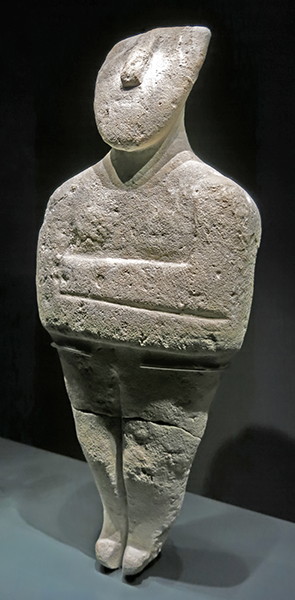
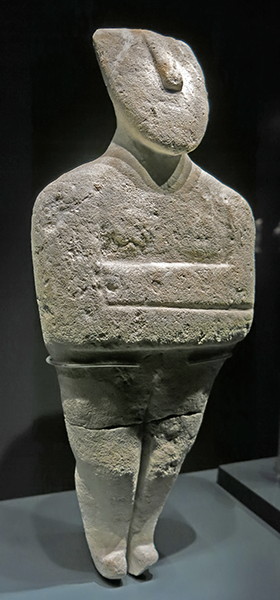
Cyclades idol
2 700 BC - 2 400 BC, pumice.
This idol has a board-like body with a flat chest. From the hip, the closed legs form a triangular shape and end in strikingly small feet. The face has a broad, angular nose and the mouth is carved.
Photo: Don Hitchcock 2015
On loan from: Staatlichen Museen zu Berlin Antikensammlung (Collection of Classical Antiquities)
Source and text: Archäologische Staatssammlung München
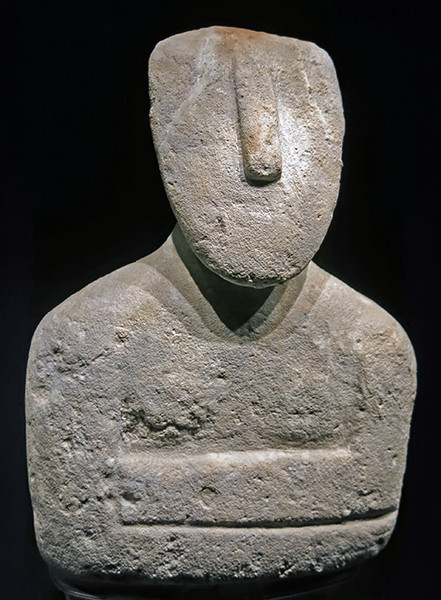
Cyclades idol
2 700 BC - 2 400 BC, pumice.
Head and upper torso.
Due to the characteristic structure of the pumice stone, the surface is more porous than idols made of marble.
( the Cyclades island of Santorini contains huge quantities of pumice, quarried since ancient times, and the pumice for this idol may well have come from there - Don )
Photo: Don Hitchcock 2015
On loan from: Staatlichen Museen zu Berlin Antikensammlung (Collection of Classical Antiquities)
Source and text: Archäologische Staatssammlung München
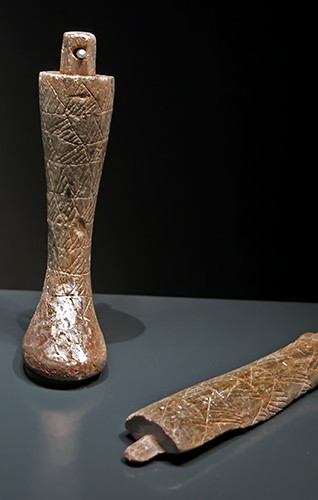
Two legs of a figurine, greenschist.
Attica, 2 700 BC - 2 400 BC, greenschist.
These two separately made greenschist legs are unique. They were attached to the figure of another object, probably of transient material.
Photo: Don Hitchcock 2015
On loan from Karlsruhe Badisches Landesmuseum
Source and text: Archäologische Staatssammlung München
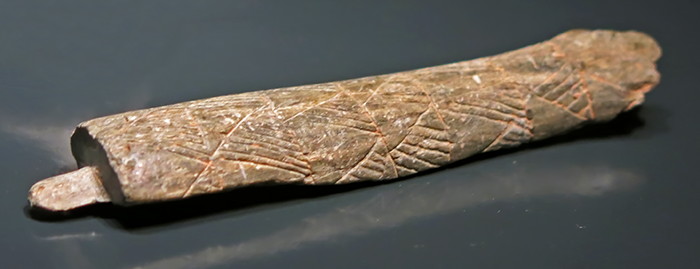
Leg of a figurine, greenschist.
Attica, 2 700 BC - 2 400 BC, greenschist.
The embellishments with hatched triangular bands are characteristic of Cycladic objects. This unusual material is probably related to the site Attica, where greenschist originates.
Photo: Don Hitchcock 2015
On loan from Karlsruhe Badisches Landesmuseum
Source and text: Archäologische Staatssammlung München

Legs of a figurine.
Attica, 2 700 BC - 2 400 BC, greenschist.
Catalog: Inv. 70 / 18b.c
Photo: Don Hitchcock 2018
Source and text: Karlsruhe Badisches Landesmuseum
Groups of idols and pregnant women
In rare cases, several idols are placed together into group compositions.
For example, there is a group of two with a little idol on the head of the bigger one, as shown here in the centre of the image above.
Another type of composition are two figures who stand side by side and put one arm on each other's shoulders. The free arm is placed, like the idols, under the breast. An extension of this concept is the threesome, such as in one case where two idols carry on their arms a third, which is shown in the attitude of one enthroned.
The deviations from the usual types and their rarity suggest special functions for such groups. However, the lack of meaningful data makes it impossible to make any further statements.
In some female idols, the abdominal area is particularly emphasised. Occasionally the sculpture shows such a bulge of the abdomen that it may represent a pregnancy. At the same time, these depictions are reminiscent of the obese idols of the Neolithic period. In any case, the aspect of female fertility is emphasised in this case.
The objects shown here are treated in detail below.
Photo: Don Hitchcock 2015
Source and text: Archäologische Staatssammlung München

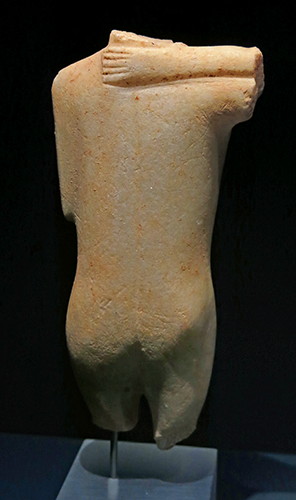
Fragment of a group sculpture.
2 700 BC - 2 400 BC, marble.
This fragment of a female cyclad idol of the Spedos type was originally part of a group consisting of two idols.
The two idols stood side by side and gripped each other's shoulders. The meaning of such compositions can only be speculated upon.
Catalog: inv. 82/6
Photo: Don Hitchcock 2018, 2015
On loan from Karlsruhe Badisches Landesmuseum
Source and text: Archäologische Staatssammlung München
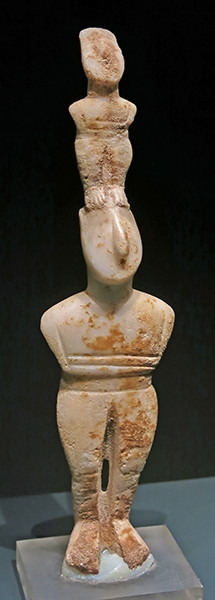
Double Idol.
Paros, 2 700 BC - 2 400 BC, marble.
On the head of this idol of the Spedos type stands a smaller one of the same kind. Although neither idol has an indication of sex, it may be of two female figures. Such idols are rare and difficult to interpret. They were certainly connected with specific religious ideas.
Photo: Don Hitchcock 2015
On loan from Karlsruhe Badisches Landesmuseum
Source and text: Archäologische Staatssammlung München
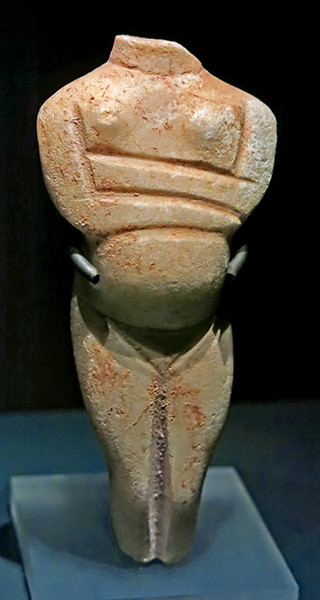
Cyclades Idol.
2 700 BC - 2 400 BC, marble.
Fragment of an idol of the Spedos type, whose strongly protruding belly indicates a pregnancy, emphasising the aspect of female fertility.
Photo: Don Hitchcock 2015
On loan from Karlsruhe Badisches Landesmuseum
Source and text: Archäologische Staatssammlung München

Cyclades Female Idol.
2 700 BC - 2 400 BC, marble.
This example of the usual or 'canonical' form represents a naked woman with crossed arms. The legs are straight, but the feet are missing.
Catalog: either 63/67 or 63/46
Photo: Don Hitchcock 2018
Source and text: Karlsruhe Badisches Landesmuseum
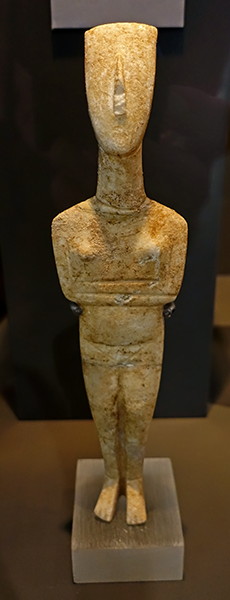
Cyclades Female Idol.
There was no card with this exhibit, but it is an example of the usual or 'canonical' form representing a naked woman with crossed arms and outstretched feet.
Catalog numbers for the glass cabinet in which it resided include:
63/46, 64/100, 77/59, 63/48, 63/49, 63/103, 75/11, 63/50, 75/49
Photo: Don Hitchcock 2018
Source and text: Karlsruhe Badisches Landesmuseum
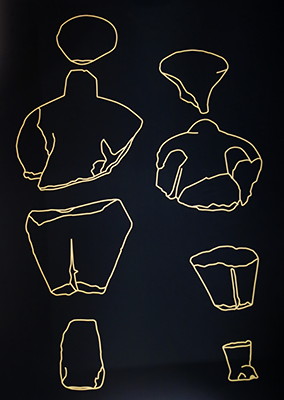
The riddle of the broken idols
The earliest evidence for marble idols in the Aegean region are the so-called Kiliya idols of the 5th and 4th millennium BC. They are found mainly in Asia Minor and the northern Greek mainland. Individual idols of this type are known from early Cycladic findings - there were direct connections between the two. Especially in the nature of their abstractive body representation, the Kiliya idols prove to be the forerunners of the Cyclades idols.
Interestingly enough, for the Kiliya idols as well as for the Cycladic idols there are find complexes with numerous broken idols. There are certainly no accidental fractures, as they occur regularly on the most stable parts of the body. Rather, they are obviously deliberate smashes that have to be related to ritual practices. The present complex of Kiliya idols shows that they were systematically broken up into four parts: Head, upper body, lower body and feet.
Excavations on the small Cycladic island of Keros have shown that in a sacred place, parts of smashed Cycladic idols were ritually laid down - as offerings that at the same time mark the end of the ritual use of the idols in question.
Artist: Unknown
Photo: Don Hitchcock 2015
Source and text: Archäologische Staatssammlung München
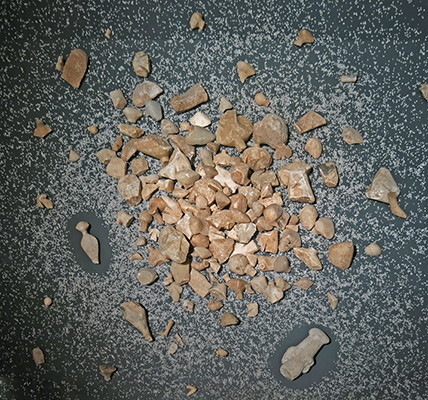
A find complex of battered idols
4th millennium BC, marble
Intentionally destroyed idols of a find complex of Kiliya idols: numerous heads, upper body, lower body and feet. The individual pieces do not match. The types of fractures testify to a deliberate smashing.
München, Archäologische Staatsammlung.
Photo: Don Hitchcock 2015
Source and text: Archäologische Staatssammlung München

Battered idols
4th millennium BC, marble
( no doubt the breaking of the idols was an important ritual for the participants, but from a modern perspective it is very sad to see such fine work destroyed - Don )
München, Archäologische Staatsammlung.
Photo: Don Hitchcock 2015
Source and text: Archäologische Staatssammlung München
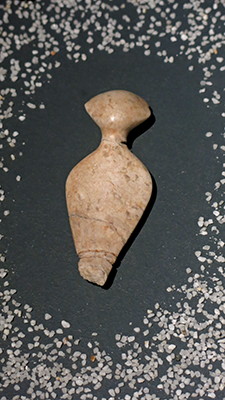
Asia Minor idol.
4th millennium BC marble
This example belonging to the environment of the Kiliya idols shows in its closed body similarities with the Cycladic idols. The arms are completely integrated into the body contour. The head is designed in a stringently closed form, the ears indicated only by fine notches.
München, Archäologische Staatsammlung.
Photo: Don Hitchcock 2015
Source and text: Archäologische Staatssammlung München
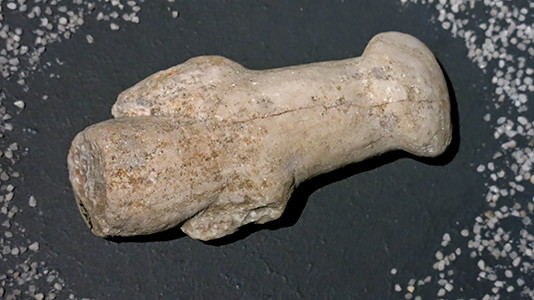
Early Cycladic idol
Paros, 3 200 BC - 2 4900 BC, marble
This top of an idol from Paros is a hybrid of features of the Kiliya idols with their wing-like arms and the early Cycladic shape of a wide neck with a knob-like head. It is thus almost a 'missing link' between the two idol groups.
On loan from: Bonn Akademisches Kunstmuseum
Photo: Don Hitchcock 2015
Source and text: Archäologische Staatssammlung München
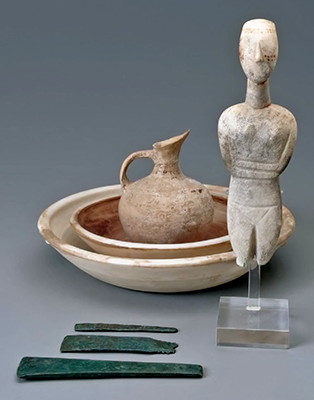
Grave finds from Iraklia, a small island between Naxos and Ios.
Iraklia, 2 700 BC - 2 400 BC, marble.
The grave inventory consists of an idol, two marble bowls, one beaked jug and three bronze tools, including two chisels and a hatchet. The idol has rich remains of painting, and one of the bowls is painted with red.
The prestigious metal tools, the well carved marble bowls and the relatively large, high quality idol suggest
that the person buried had a high social rank.
Photo: Horst et al. (2015)
Source and text: Archäologische Staatssammlung München

Grave find from Iraklia, a small island between Naxos and Ios.
Iraklia, 2 700 BC - 2 400 BC, marble.
Judging by the bronze objects included, it may be the grave goods of a male burial. The tools indicate that the buried person was doing manual labour during his lifetime.
Photo: Don Hitchcock 2015
Source and text: Archäologische Staatssammlung München
Additional text: Wikipedia

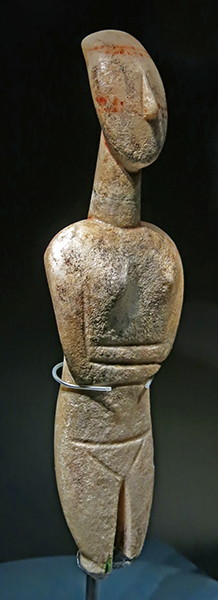
Cyclades idol
Iraklia, 2 700 BC - 2 400 BC, marble.
Grave find from Iraklia, a small island between Naxos and Ios.
This idol of the Spedos type shows clear traces of colour. The back and neck lines are red, as are the rows of points on the forehead and cheeks.
Just recognisable are the remains of eyes and eyebrows created with black paint. Traces of green copper oxide on the leg are due to contact with one of the bronze tools which were also part of the grave goods.
( The image on the left is valuable, since it shows clearly the shape of the head of this idol - Don )
Photo: Don Hitchcock 2015
Source and text: Archäologische Staatssammlung München
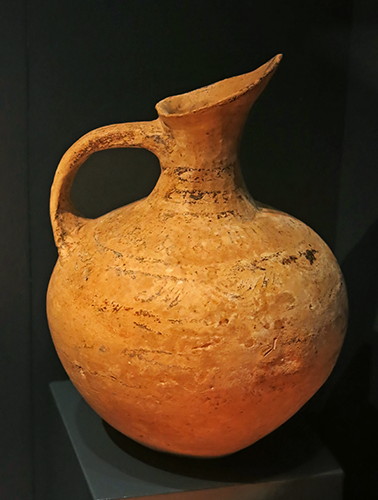
Beak spouted ewer.
Iraklia, 2 700 BC - 2 400 BC, ceramic.
Grave find from Iraklia, a small island between Naxos and Ios.
This spouted jug made of yellow-brown ceramic is decorated with dark brown ornaments: ribbons, bows and Kreisaugen - small ornaments popular at the time, consisting of a circle with a small central point.
Photo: Don Hitchcock 2015
Source and text: Archäologische Staatssammlung München
Additional text: Wikipedia
Marble bowls
Iraklia, 2 700 BC - 2 400 BC, ceramic.
Grave find from Iraklia, a small island between Naxos and Ios.
(left): Large marble bowl with figuratively crafted handles. The wall of this elegant bowl has been made so thin that it is translucent.
(right): The inside of this bowl is painted completely in red. Red is a colour with a highly symbolic meaning. Here, the painting could allude to the bowl being filled with either wine or blood.
Photo: Don Hitchcock 2015
Source and text: Archäologische Staatssammlung München
Other items of interest
Stoneware - testimony to superb skills
The stone vessels of Cycladic culture are of timeless elegance. In their perfect form and flawlessness, they are just as awe-inspiring today as when they were first made. They are astonishing, especially since they were laboriously wrested from marble after long carving, grinding and drilling.
Stone-cutting as an art form had already begun in the Neolithic Age, but it reached its zenith in the early Bronze Age, with the variety of shapes and complexity of the vessels. In most cases, the stone vessels imitate clay models and lend the forms a high visual appeal through the translucent material of the marble. Other rocks such as green chlorite schist were also used besides marble.
The vessels are decorated with hatchings, herringbone patterns and spirals - typical motifs, which also occur in ceramics. Eyelets allow the threading of strings so that the vessel can be hung.
The durability of the stone and the expense of production indicate that the main use of the stone vessels was as prestigious burial objects.
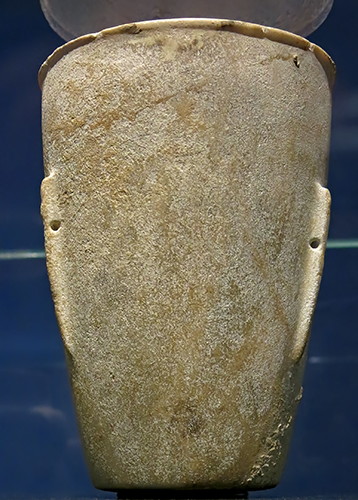
Steep walled mug with eyelets for cords.
Paros, 3 200 BC - 2 900 BC, marble.
Marble mug with lateral eyelets for cords are a characteristic early-cycle form. The special thing about this piece are the four instead of the usual two eyelets. The shape evolved from Neolithic marble pots with pointed bases. Perhaps they served as sumptuous drinking vessels.
Photo: Don Hitchcock 2015
On loan from Karlsruhe Badisches Landesmuseum
Catalog: Inv. 63/48
Source and text: Archäologische Staatssammlung München
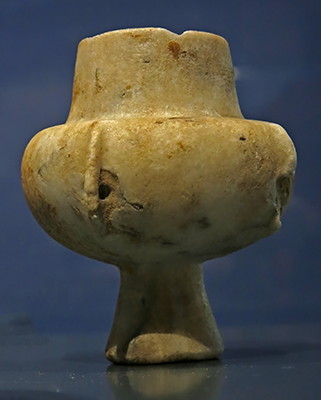
Cycladic cone neck vessel.
Naxos, 3 200 BC - 2 900 BC, marble.
The bulbous form, which is unsuitable for the material, is based on ceramic models. The drilling of the interior of the vessel is incomplete and does not exceed the width of the neck, so that the vessel is quite heavy. This hollowing of the conical neck seems to have been done with a kind of lathe.
Photo: Don Hitchcock 2015
On loan from Bonn Akademisches Kunstmuseum
Source and text: Archäologische Staatssammlung München
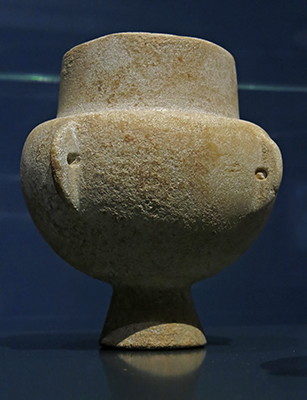
Cycladic cone neck vessel.
Paros, 3 200 BC - 2 900 BC, marble.
The marble conical neck bowls were probably not intended for the living because of the material, the high weight and the elaborate production, but served as valuable grave goods for the dead.
Photo: Don Hitchcock 2015
On loan from Karlsruhe Badisches Landesmuseum
Source and text: Archäologische Staatssammlung München
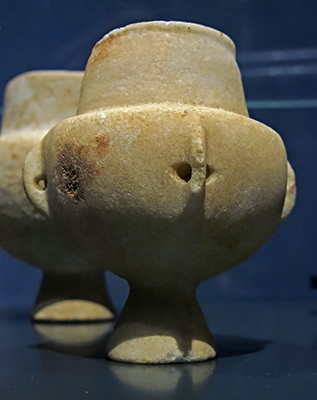
Cycladic cone neck vessel.
Paros, 3 200 BC - 2 900 BC, marble.
The earliest cone-neck vessels come from the small grave field of Plastiras on Paros and belong to the time that gave birth to the first fully sculpted marble figurines. Marble cone neck vessels, which were comparatively numerous, can be described as the model of the Plastiras group.
Photo: Don Hitchcock 2015
On loan from Antikenmuseum der Universität Heidelberg
Source and text: Archäologische Staatssammlung München
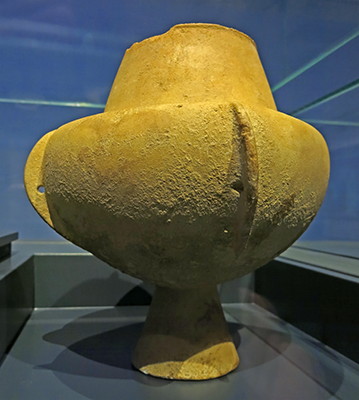
Cycladic cone neck vessel.
Iraklia, 3 200 BC - 2 900 BC, marble.
This cone neck vessel is one of the largest specimens of its genus. With a weight of 13 kg it is too heavy to use in everyday life.
It is a display vessel, which was especially made as a grave gift. The incomplete drilling out of the vessel body also speaks in favour of this interpretation.
Photo: Don Hitchcock 2015
Source and text: Archäologische Staatssammlung München
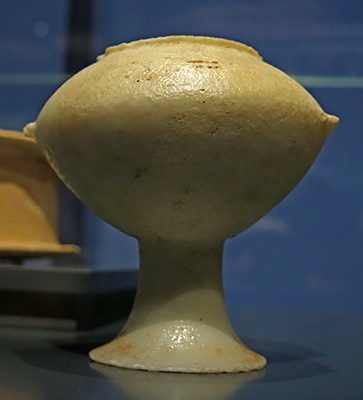
Footed Pyxis.
2 700 BC - 2 400 BC, marble.
This vessel on a high massive foot is a rarer variant of the globular pyxis. Originally, this piece was closed with a lid.
( a Pyxis is normally a box of cylindrical shape having a lid with a knob in the centre, used for toilet articles - Don )
Photo: Don Hitchcock 2015
On loan from Karlsruhe Badisches Landesmuseum
Source and text: Archäologische Staatssammlung München
Additional text: https://www.dictionary.com/browse/pyxis
Pyxis.
2 700 BC - 2 400 BC, marble.
Marble spool-like pyxis with engraved decoration and lid. Holes in the bottom plate and in the lid of the can-like vessel allow a closure by means of lacing. The vessel itself is very well made to accurate measurements.
( note that the base is also domed as well as the lid - Don )
Photo: Don Hitchcock 2015
On loan from Karlsruhe Badisches Landesmuseum
Source and text: Archäologische Staatssammlung München
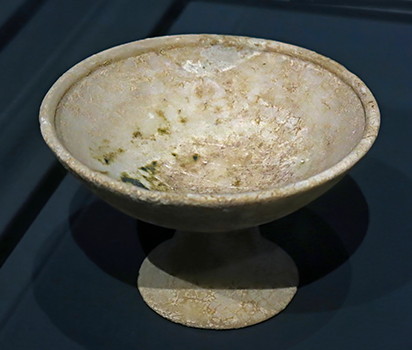
Footed bowl.
2 700 BC - 2 400 BC, marble.
Photo: Don Hitchcock 2015
On loan from Karlsruhe Badisches Landesmuseum
Source and text: Archäologische Staatssammlung München
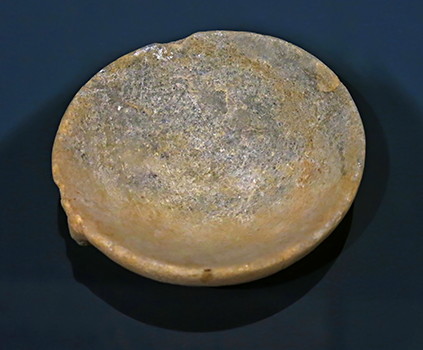
Shallow lugged bowl.
3 200 BC - 2 900 BC, marble.
Marble bowls with simple eyelets are one of the most common forms of early Cycladic culture. The eyelets allow the vessel to be hung from a cord. There were traces of paint in some of them, suggesting that they were often used to prepare colourants.
Photo: Don Hitchcock 2015
On loan from Karlsruhe Badisches Landesmuseum
Source and text: Archäologische Staatssammlung München

Animal vessel
3 200 BC - 2 400 BC, marble.
This type of extraordinary vessel in the form of a two-headed bird is unique to the Cycladic culture. Occasionally, bird figurines are used as a bead and needle attachment.
The rarity of this vase shape and the occasional use of a bird form as a jewellery pendant could point to a religious aspect which finds its expression here.
Photo: Don Hitchcock 2015
On loan from Karlsruhe Badisches Landesmuseum
Source and text: Archäologische Staatssammlung München
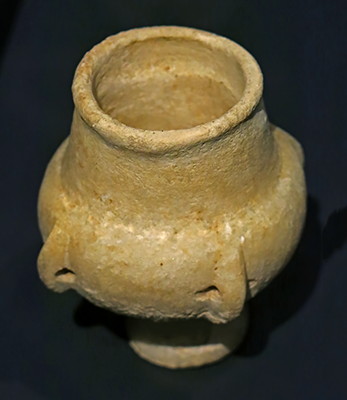
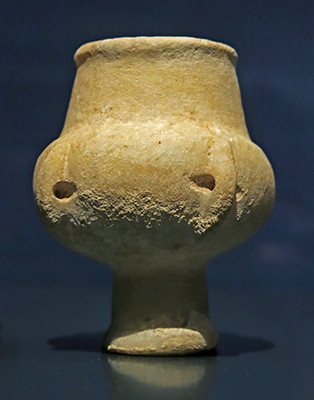
Cone necked vessel, Kegelhalsgefäss
3 200 BC - 2 900 BC, marble.
This small miniature cone-neck vessel is unlikely to have fulfilled a practical purpose. It was filled with a substance, but rather just as a burial object.
The unusual proportions and the inclination of the vessel to the side speak to the fact that it was not the work of an experienced stone worker.
Photo: Don Hitchcock 2015
On loan from Karlsruhe Badisches Landesmuseum
Source and text: Archäologische Staatssammlung München
Bowl
2 700 BC - 2 400 BC, marble.
Simple round bowls made of marble form one of the largest groups among the Cyclades stone vessels.
Occasionally, traces of paint are visible on the inside, suggesting the use of these bowls in the area of colour mixing. Generally, however, trays of this type are useful for a variety of purposes.
Photo: Don Hitchcock 2015
On loan from Karlsruhe Badisches Landesmuseum
Source and text: Archäologische Staatssammlung München
Small footed bowls
2 700 BC - 2 400 BC, marble.
Hemispherical bowls on trumpet-shaped feet were widely used at the zenith of Cycladic culture, and are found in both marble and clay.
These footed bowls were found in a tomb, along with two simple marble bowls and marble figures of two harpists.
Photo: Don Hitchcock 2015
On loan from Karlsruhe Badisches Landesmuseum
Source and text: Archäologische Staatssammlung München
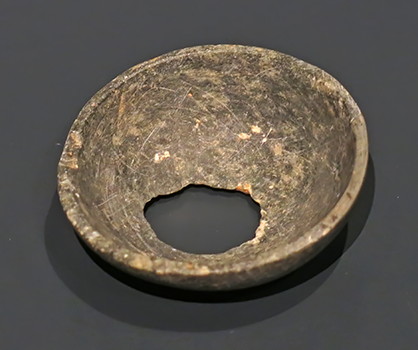
Bowl
Porto Raphti / Attica, 2 700 BC - 2 400 BC, chlorite schist.
Small bowl of chlorite schist with a broken bottom. It may have originally had a trumpet-shaped foot.
Photo: Don Hitchcock 2015
On loan from Karlsruhe Badisches Landesmuseum
Source and text: Archäologische Staatssammlung München
Pyxis
2 700 BC - 2 400 BC, steatite.
Double conical pyxids are typical of the early Cycladic culture. Two pairs of perforated eyelets on the sides allow a lacing to be made to fasten a lid. These vessels are often decorated with herringbone patterns, parallel lines or triangular patterns.
Photo: Don Hitchcock 2015
On loan from Martin von Wagner Museum, University of Würzburg
Source and text: Archäologische Staatssammlung München
Büchse (Pyxis) with eyelets for cord
Porto Raphti/Attika, 2 700 BC - 2 400 BC, steatite.
Supposedly found on the Greek mainland, this pyxis resembles Cycladic pieces. If the location is correct, this is a testimony to the widespread use of Cycladic objects in the Aegean.
This is an exceptional example, thin-walled and thus light in weight, a difficult achievement at the time.
Catalog: Inv. 72/76
Photo: Don Hitchcock 2015
On loan from Karlsruhe Badisches Landesmuseum
Source and text: Archäologische Staatssammlung München
Additional text: Karlsruhe Badisches Landesmuseum
Pyxis
Dali(?)/Crete, 2 700 BC - 2 400 BC, steatite.
This high quality pyxis with lid and beautiful spiral decoration comes from Crete, but was made in a Cycladic workshop and proves the close cultural contacts between the Greek islands.
Photo: Don Hitchcock 2015
Source and text: Archäologische Staatssammlung München
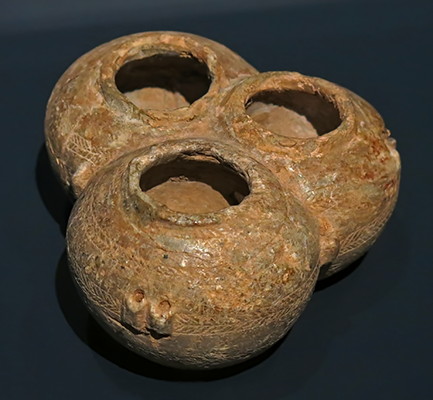
Tripartite Pyxis
2 700 BC - 2 400 BC, steatite.
This unusual Pyxis has been created by the imitation of similar earthenware objects. The pot could be suspended by the three double eyelets.
Photo: Don Hitchcock 2015
On loan from Karlsruhe Badisches Landesmuseum
Source and text: Archäologische Staatssammlung München
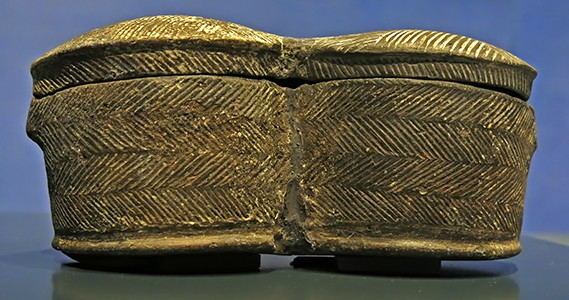
Double Pyxis
3 200 BC - 2 900 BC, ceramic.
The vessel wall and lid of the two pyxids, which have been attached to each other, are decorated with a herringbone pattern, which possibly hints at wickerwork structures. Perhaps the potters modelled the pattern on cylindrical rush baskets as they are still used today in the Cyclades.
Photo: Don Hitchcock 2015
On loan from Antikenmuseum der Universität Heidelberg
Source and text: Archäologische Staatssammlung München
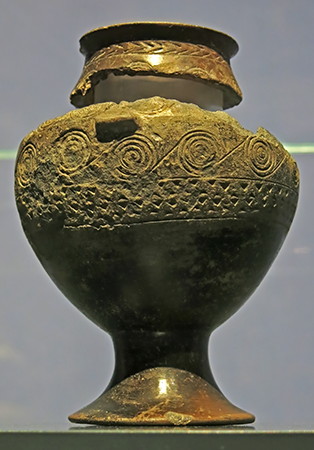
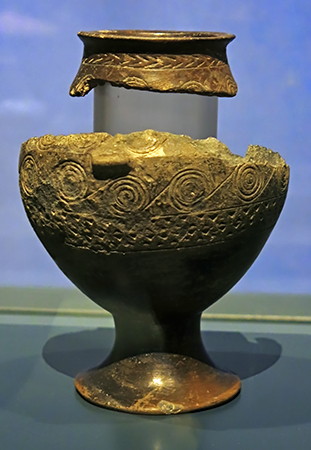
Kegelhalsgefäss, kandela, cone necked vessel, fragmentary
Syros, 2 700 BC - 2 400 BC, ceramic.
The stamped patterns were originally encrusted with a white, calcareous substance. The bright motifs once had to stand out well from the dark, polished surface. Spirals were a popular ornamental element in the Mediterranean region, repeatedly used, with a range of variations.
Photo: Don Hitchcock 2015
On loan from Antikenmuseum der Universität Heidelberg
Source and text: Archäologische Staatssammlung München
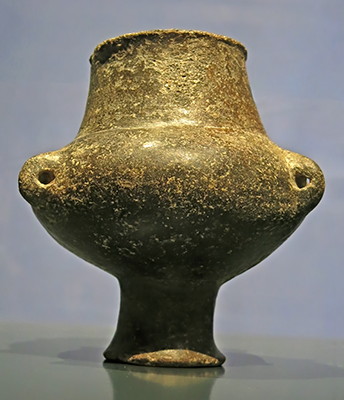
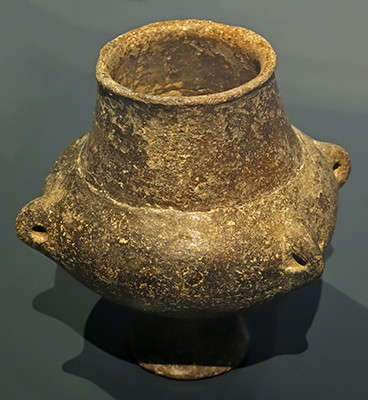
Kegelhalsgefäss, kandela, cone necked vessel
Syros, 3 200 BC - 2 900 BC, ceramic.
The cone-neck vessel is one of the leading forms of early Cycladic culture and is very common in clay as well as in marble. This form of vessel played an important role In the life of the Cyclades inhabitants. It probably served as a storage vessel.
Photo: Don Hitchcock 2015
On loan from Karlsruhe Badisches Landesmuseum
Source and text: Archäologische Staatssammlung München
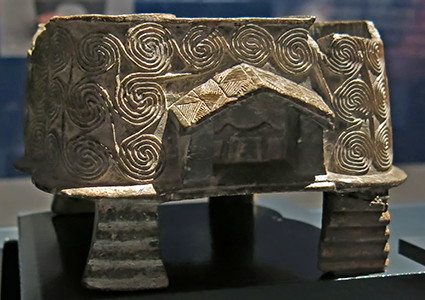
Stone vessel in temple form
Melos, 2 700 BC - 2 400 BC, slate.
This stone vessel, which has the shape of a house, is a unique piece. It is supported by four grooved pillars. Spiral motifs adorn the vessel wall.
At the front there is a door with a gabled roof. The interior is divided into a central open courtyard with seven surrounding round chambers. Possibly it is meant to be a temple with storage for dedications. Such precious vessels were used to store cosmetics and jewellery.
Photo: Don Hitchcock 2015
Source and text: Archäologische Staatssammlung München
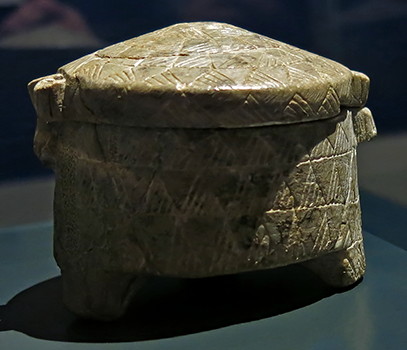
Stone vessel in hut form
Syros, 2 700 BC - 2 400 BC, steatite.
This steatite miniature vessel is a so-called hut pyxis, i.e. a storage vessel in the form of a house or a hut. It was found together with three Cycladic idols and other vessels from a grave on the island of Syros. It stands on three feet, and eyelets on the vessel and on the lid were used for closing. The walls and lids are decorated with triangular patterns reminiscent of woven reed walls and roof.
Photo: Don Hitchcock 2015
On loan from: Staatlichen Museen zu Berlin Antikensammlung (Collection of Classical Antiquities)
Source and text: Archäologische Staatssammlung München
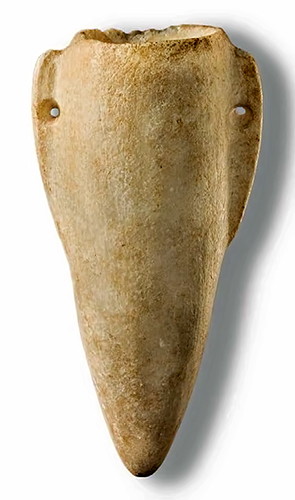
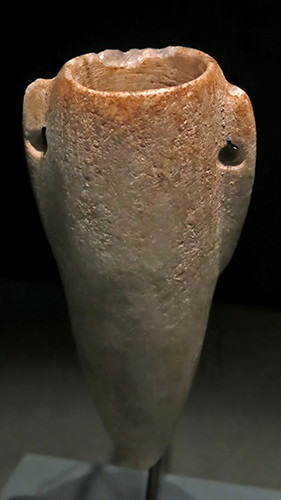
Cone shaped cup
Naxos, 4th - 5th Millennium BC, marble
This vessel shape is a late Stone Age precursor of the Cycladic marble cups. The cups, which are manufactured with high craftsmanship and the most accomplished stone cutting techniques, can be found not only in the Cyclades, but also on the coast of Asia Minor and the Black Sea.
As with idols, this also shows the early integration of the Cyclades with the surrounding cultural areas. In its strictly reduced form the cup is stylistically closely connected with contemporary idols.
Photo (left): Horst et al. (2015)
Photo (right): Don Hitchcock 2015
On loan from the Badisches Landesmuseum Karlsruhe
Source and text: Archäologische Staatssammlung München
Ceramics - the everyday utensils of the Cyclades culture
Clay pots form the basis for the temporal classification and development of Cycladic culture. Initially, people in the Cyclades used mainly hand-made pots, pyxids with lids and conical neck vessels. Later, the potter's wheel was used and the vessel shapes change. It created pans, cups, footed bowls, , beak spouted ewers and various special forms. In the final phase, many old forms were abandoned and new things created: animal-shaped containers appear and vessel shapes are more abstract. For the stone vessels, a similar development can be detected. The ornamentation of the vessels initially consists of incised herringbone patterns or lines, later notched patterns were added, as well as concentric circles and spirals. Often motifs are used that are similar to the patterns of woven baskets. At the zenith of Cycladic culture, the patterns on the clay pots are occasionally painted with a black varnish.Text above: Archäologische Staatssammlung München
Bronze tools and household kitchen ware.
Naxos, Amorgos, Sikinnos, 2 700 BC - 2 400 BC.
Photo: Don Hitchcock 2015
Source and text: Archäologische Staatssammlung München
Bronze tools from the 'Kythnos-Treasure'
Naxos, 2 700 BC - 2 400 BC.
From a large hoard in a cave on Naxos come four bronze tools: two hatchets, an axe and a chisel. The concealment of such metal products results from their high material value and prestige value in Early Bronze Age society. The concealment of such metal products results from their high material value and prestige value in Early Bronze Age society.
The four tools show signs of wear. They could have been used in a variety of ways, for example in shipbuilding or house building. The two hatchets have rectangular holes for attaching the handles. The axe has the shape of a kite. A large round hole was used to attach it to the handle. The chisel has a rectangular cross section. One end is broken.
( The so-called 'axe' is interesting. To me it looks far more like what is called in Australia a block buster. Implements of this type are typically used for splitting blocks of wood for firewood, and need to have a large angle of attack in order that the implement does not so easily get jammed. It needs to be very heavy, so that, swung from above the head, it carries a large amount of energy to be expended in splitting a billet of wood.
A good axe has a very much narrower angle of attack. It is meant for cutting down trees, and needs to be very sharp and relatively thin to accomplish this task. It is meant to dislodge large chips and flakes of wood from the green wood. The 'hatchets' above are designed with this task in mind.
Occasionally even a block buster gets jammed - and sometimes the only remedy is to crash through or crash - that is, to pound the back of the blockbuster with a sledgehammer or similar, until the blockbuster splits the wood, and is freed. I note that the maker of the 'kite shaped axe' has included a large knob on the back of the head of the 'axe' which would facilitate this need.
The 'chisel' may also have been used for a quite different purpose. When a tree is cut down, it typically needs to be cut or split into planks. This could most efficiently be done in pre-circular-saw days by using a set of metal wedges. The first is driven in to one end of the log, creating a small split. The next is pounded in a little further along the split, followed by others, until the entire log splits apart into two equal halves. This process is then repeated until the required number and thickness of planks is obtained - Don )
Photo: Don Hitchcock 2015
Source and text: Archäologische Staatssammlung München
Tomb complex of Arkesine, grave goods.
Arkesine/Amorgos, 2 250 BC - 2 000 BC.
In the town of Arkesine on the island Amorgos around 1885 this grave complex was discovered. The two-story tomb was unusually deep and partially filled with rubble.
The rich assembly of ceramic products dates back to the last phase of early Cycladic culture.
The ensemble of vessels included a two-handled storage vessel with sculptural and painted decorations. The spout of one pot is designed like a bird's head. Round clay nubbins on the vessel bodies indicate female nipples. Many cultures have such symbolic connections between vessels and life-giving female breasts. One pair of such nubbins may be seen on the painted vase on the leftmost image above.
( All of these pots appear to have been thrown on a pottery wheel, and/or have been made by highly skilled potters - Don )
Photo: Don Hitchcock 2015
On loan from the Københavns Nationalmuseet
Source and text: Archäologische Staatssammlung München

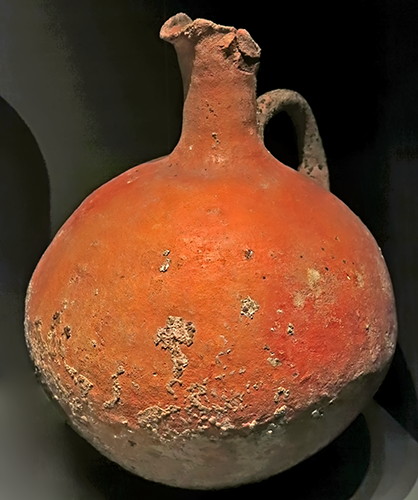
Tomb complex of Arkesine, grave goods.
Arkesine/Amorgos, 2 250 BC - 2 000 BC.
( On the left image of a spouted jug, another pair of nubbins representing the life giving nipples of female breasts may be seen. Note also that both jugs are definitely hand built coil pots, rather than being thrown on a pottery wheel - Don )
Photo: Don Hitchcock 2015
On loan from the Københavns Nationalmuseet
Source and text: Archäologische Staatssammlung München
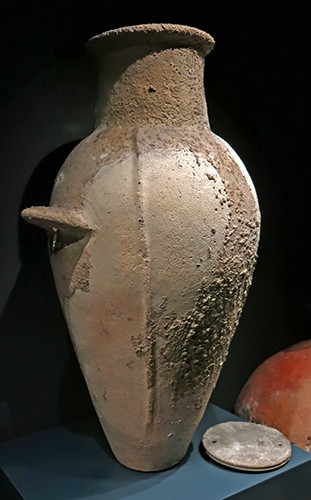
Tomb complex of Arkesine, grave goods.
Arkesine/Amorgos, 2 250 BC - 2 000 BC.
Two handled storage vessel.
Photo: Don Hitchcock 2015
On loan from the Københavns Nationalmuseet
Source and text: Archäologische Staatssammlung München
Cyclades pan
Tomb complex of Arkesine, grave goods.
Sikinnos, 2 700 BC - 2 400 BC, ceramic.
Lidded bowl with broken handle. The decor consists of a spiral band, which is arranged around a central motif of concentric circles. The wall is decorated with a spiral decoration.
Such items probably served in the context of religious festivals as donation bowls for ritual purification.
Photo (left): Don Hitchcock 2015
Photo (right): Horst et al. (2015)
On loan from the Københavns Nationalmuseet
Source and text: Archäologische Staatssammlung München

Tomb complex of Arkesine, grave goods.
Arkesine/Amorgos, 2 250 BC - 2 000 BC.
This bronze dagger is a significant find. It is based on older stabbing weapons. The dagger shows that this is a male burial. The rich grave goods also pointed to the high social rank of the deceased.
Photo: Don Hitchcock 2015
On loan from the Københavns Nationalmuseet
Source and text: Archäologische Staatssammlung München
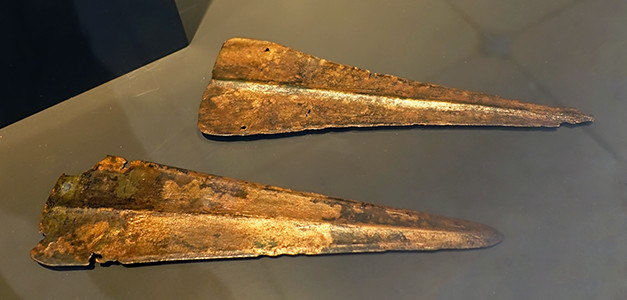
Two daggers
Amorgos, 2 700 BC - 2 300 BC.
Daggers of this kind were widely used in early Bronze Age Greece. Besides the spear, they could be part of the equipment of a warrior.
Made of arsenical Bronze. The use of arsenic in bronze results in stronger final product and better casting behaviour.
Catalog: Inv. F 1893, F 1894
Photo: Don Hitchcock 2018
Source and text: Karlsruhe Badisches Landesmuseum
Additional text: Wikipedia
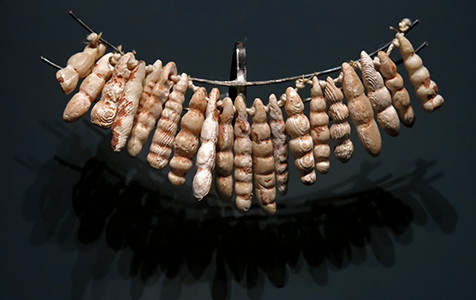
Necklace
3 000 BC - 2 500 BC, seashells.
This item was found in a cone neck vessel.
Occasionally, sea shells are part of grave furnishings, but the meaning of this custom is unclear. Were such objects only picked up on the beach because of their attractive appearance and added to the grave for this reason only, or was it a symbolic addition with a meaning unknown to us?
Catalog: Inv. 67/75
Photo: Don Hitchcock 2015
On loan from Karlsruhe Badisches Landesmuseum
Source and text: Archäologische Staatssammlung München
Rectangular plates.
Attica, 3 200 BC - 2 900 BC, marble.
Rectangular marble dishes or plates are frequently found items in the Cyclades. They probably served as cosmetic pallets.
Traces of colour exist on some specimens.
Originally, carved pieces of bone were used instead of marble.
Photo: Don Hitchcock 2015
On loan from Karlsruhe Badisches Landesmuseum
Source and text: Archäologische Staatssammlung München
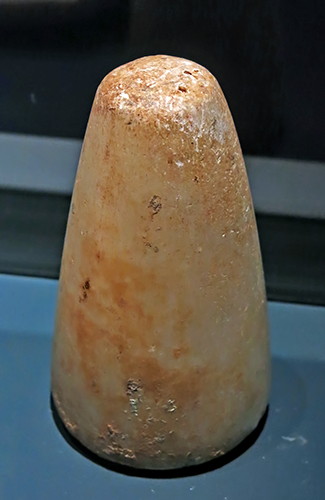
Pestle
Drios/Paros, 3 200 BC - 2 900 BC, marble.
Marble pestles were used to crush various substances. Some specimens that were found with marble mortars were discovered to have paint residues adhering to them, suggesting that they also played a role in the preparation of dyes.
Photo: Don Hitchcock 2015
On loan from Karlsruhe Badisches Landesmuseum
Source and text: Archäologische Staatssammlung München

Mortar and pestle
3 200 BC - 2 900 BC, marble.
This mortar and pestle were found together. Remains of red paint on the grinding surface of the pestle and on the inside of the mortar show that they were used to make paint.
Photo: Don Hitchcock 2015
On loan from Karlsruhe Badisches Landesmuseum
Source and text: Archäologische Staatssammlung München
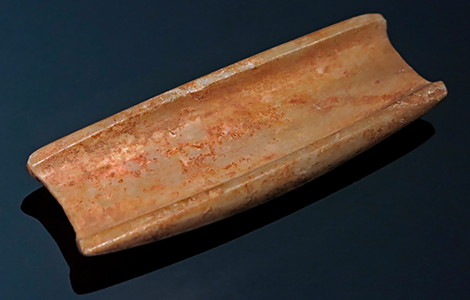
Palette
2 900 BC - 2 700 BC, marble.
This rectangular palette has on the long sides a conspicuously wide edge, while the narrow sides are flat and slightly concave. This characteristic suggests that the form follows the form of the original palettes made of bone. The piece shows traces of red, which supports the identification of this piece as a colour palette.
Photo: Don Hitchcock 2015
On loan from: München, Staatliche Antikensammlungen und Glyptothek
Source and text: Archäologische Staatssammlung München

Rubbing stone
2 900 BC - 2 400 BC, marble.
This marble rubbing stone was used to grind colour pigments. The shape fits perfectly in the hand and it compares well to modern rubbing stones.
Source and text: Archäologische Staatssammlung München
Photo: Don Hitchcock 2015
Source and text: Archäologische Staatssammlung München
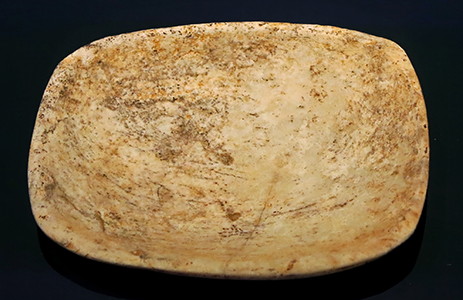
Bowl
3 200 BC - 2 900 BC, marble.
This flat, approximately square bowl has rounded corners. Comparable bowls are frequent in the Cyclades. They sometimes also served as mortars.
Photo: Don Hitchcock 2015
On loan from the Badisches Landesmuseum Karlsruhe
Source and text: Archäologische Staatssammlung München
Cyclades Cultural Artefacts from the Louvre Museum, Paris
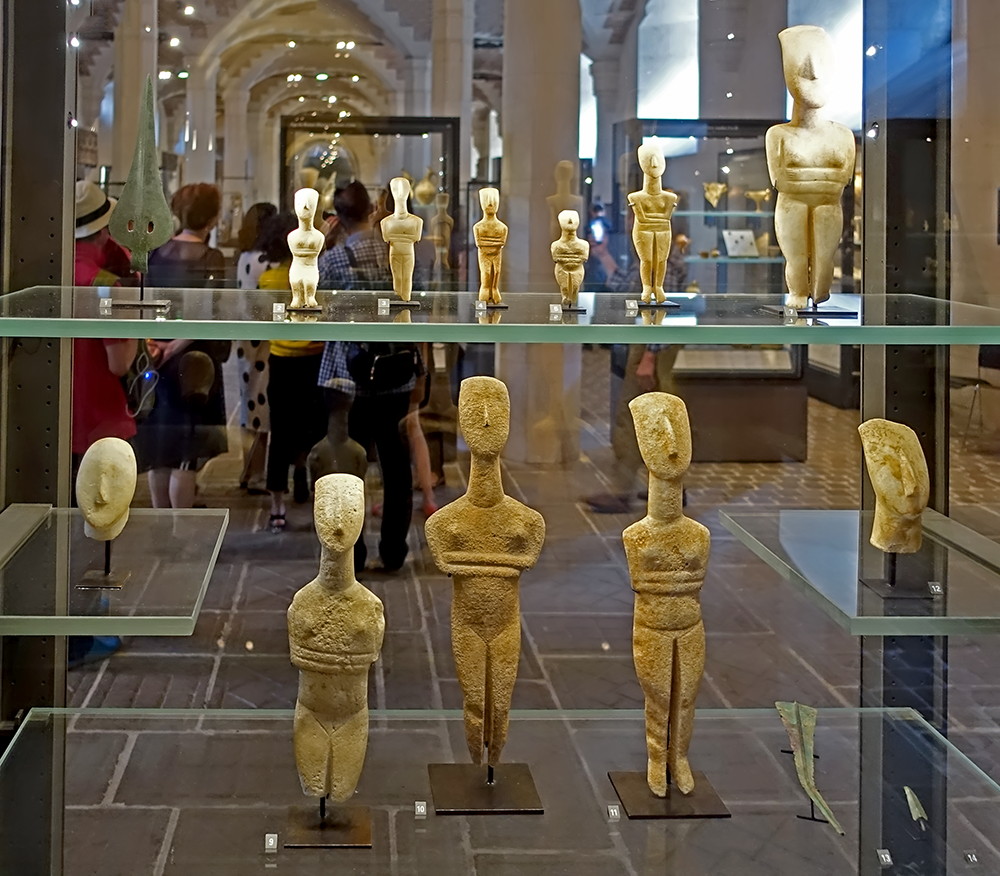
Cyclades Cultural Artefacts
Photo: Don Hitchcock 2018
Source: Original, Musée du Louvre
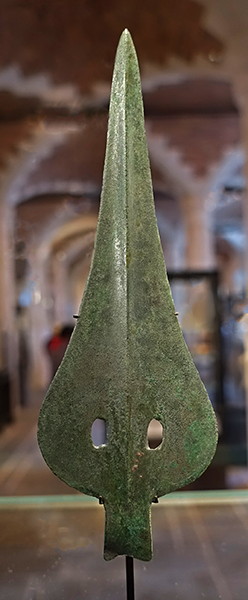
Lance Head
Amorgos, 2 700 BC - 2 300 BC
This leaf-shaped spearhead is characteristic of Cycladic objects dating from the third millennium BC. It was fitted onto a wooden shaft via holes in the lower part. The object is believed to have been found in a grave on the island of Amorgos. It may derive from Neolithic prototypes that also had a slightly raised central ridge.
This bronze spearhead entered the collections of the Louvre as part of the Delamarre donation in 1903, and is thought to come from a grave discovered on the island of Amorgós in the Cyclades islands. It is crafted in the shape of a leaf, with a slightly raised central ridge running its length. It fitted onto a wooden shaft, now lost, via two holes made in the lower part of the tang. The metal was cast and worked by hammering.
The shape of the object probably derives from a Neolithic prototype that would also have had a central ridge. It is characteristic of works made in the Cyclades in the third millennium BC. This spearhead is related to a similar type discovered in Cyprus that was produced up to the end of the third millennium BC. The Cypriot spearheads have a rat's-tail-shaped tang. The Louvre spearhead may therefore be considered as one of the oldest proofs of contact between the Aegean world and the eastern Mediterranean.
This type of weapon, which has been found on several of the Cyclades islands, is sometimes mistakenly identified as a type of dagger blade dating from the same period, whose leaf or triangular shape is indeed very similar.
This object was made in a period of the Bronze Age during which craftsmen made considerable progress in metalwork and when metallurgy was burgeoning. The metals most often used were probably copper and silver, to which were sometimes added lead, pewter and gold (these being no doubt imported). In the Cyclades, bronze was used primarily for the making of everyday objects (knives, drills, scissors, tongs, needles) and weapons (spears, daggers, arrowheads).
Photo: Don Hitchcock 2018
Catalog: Br 1459
Source: Original, Musée du Louvre
Text: https://www.louvre.fr/en/mediaimages/pointe-de-lance, https://www.louvre.fr/en/oeuvre-notices/spearhead

Seated female figurine, Syros group
Ancient Cycladic II, 2 700 BC - 2 300 BC, marble.
This figurine of the Spedos type, remarkable for its fine craftsmanship and pose, is a rare example of a three-dimensional approach to sculpture in the Third Millenium BC.
Height 121 mm.
Catalog: Ma 4992
Photo: Don Hitchcock 2018
Source & text: Original, Musée du Louvre
Additional text: http://cartelfr.louvre.fr
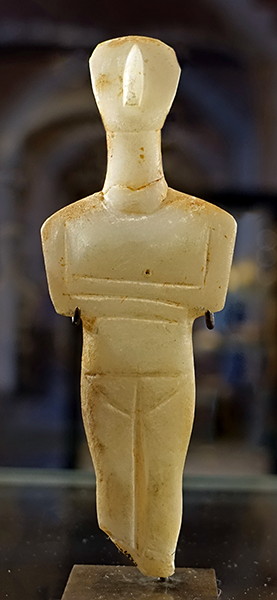
Female figurine of the Syros group, Spedos type
Ancient Cycladic II, 2 700 BC - 2 300 BC, marble.
The type of figurine with crossed arms of the Spedos variety marks the apogee of Cycladic creation in the third millennium BC.
Height 140 mm.
Catalog: Ma 4998
Photo: Don Hitchcock 2018
Source and text: Original, Musée du Louvre
Additional text: http://cartelfr.louvre.fr
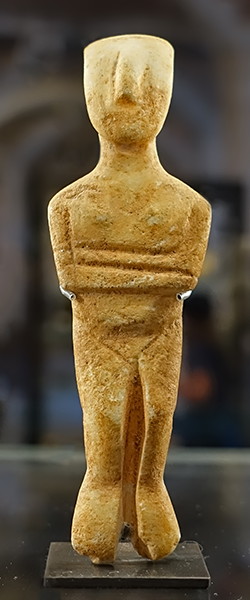
Cycladic female figurine with crossed arms, Syros group, Spedos type
Ancient Cycladic II, 2 700 BC - 2 300 BC, marble.
Catalog: Ma 4999
Photo: Don Hitchcock 2018
Source and text: Original, Musée du Louvre
Additional text: Wikipedia, http://cartelfr.louvre.fr

Cycladic female figurine with crossed arms, Syros group, Spedos type
Ancient Cycladic II, 2 700 BC - 2 300 BC, marble.
Photo: Don Hitchcock 2018
Source and text: Original, Musée du Louvre
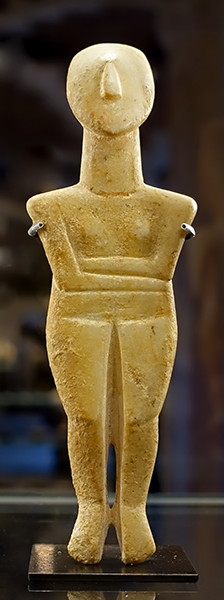
Ancient Cycladic II, 2 700 BC - 2 300 BC, marble.
Marble, height 140 mm.
The statuettes presented in this showcase belong to the type of figurines with crossed arms of type Spedos which marks the apogee of the Cycladic creation in the 3rd millenium BC.
The Spedos type is named after an Early Cycladic cemetery on the island of Naxos.
Catalog: Ma 4997
Photo: Don Hitchcock 2018
Source and text: Original, Musée du Louvre
Additional text: http://cartelen.louvre.fr
The Spedos type, named after an Early Cycladic cemetery on Naxos, is the most common of Cycladic figurine types. It has the widest distribution within the Cyclades as well as elsewhere, and the greatest longevity.Text above from Wikipedia
The group as a whole includes figurines ranging in height from miniature examples of 80 mm to monumental sculptures of 1500 mm. With the exception of a statue of a male figure, now in the Museum of Cycladic Art Collection, all known works of the Spedos variety are female figures.
Spedos figurines are typically slender elongated female forms with folded arms. They are characterised by U-shaped heads and a deeply incised cleft between the legs.
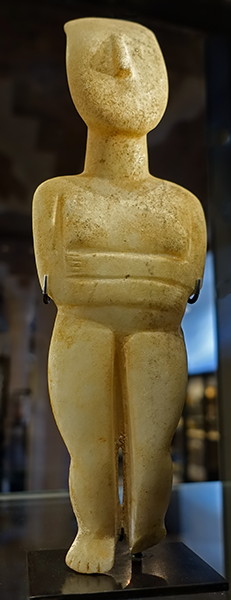
Cycladic female figurine, Syros group.
Photo: Don Hitchcock 2018
Source & text: Original, Musée du Louvre
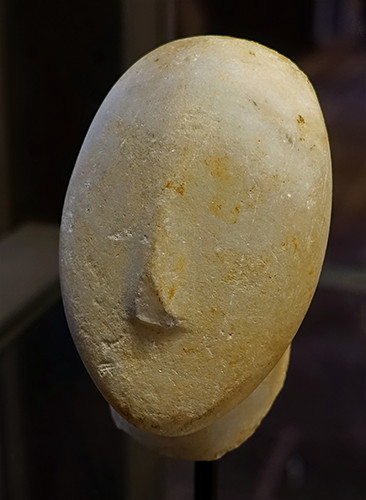
Female figurine, head, Syros Group, Spedos Type, found in a tomb at Kornovegli.
Ancient Cycladic II, 2 700 BC - 2 300 BC, marble.
Height 95 mm.
These heads, Ma 3095 and Ma 3094 (below) were found in a tomb at Kornovegli, between Arcosine and Minoa, with the knife blade Br 1460. This head, Catalog Ma 3095, is attributed to the 'Master of Goulandris'.
Catalog: Ma 3095
Photo: Don Hitchcock 2018
Source & text: Original, Musée du Louvre
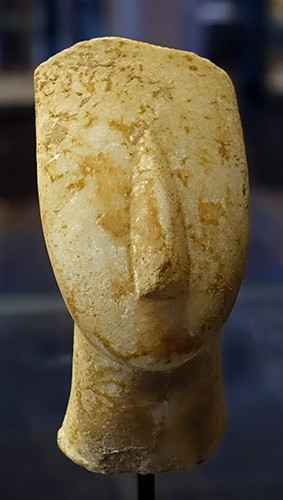
Female figurine, head, Syros Group, Spedos Type, found in a tomb at Kornovegli.
Ancient Cycladic II, 2 700 BC - 2 300 BC, marble.
These heads, Ma 3095 (above) and Ma 3094 were found in a tomb at Kornovegli, between Arcosine and Minoa, with the knife blade Br 1460.
Catalog: Ma 3094
Photo: Don Hitchcock 2018
Source & text: Original, Musée du Louvre
Additional text: Wikipedia
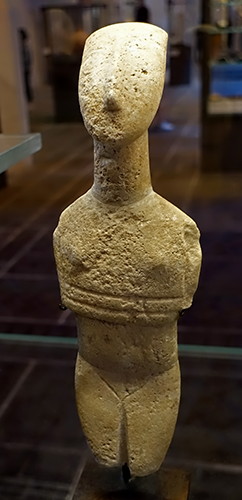
Cycladic female figurine
Ancient Cycladic II, 2 700 BC - 2 300 BC, Syros Group, Spedos Type, marble
Height: 315 mm.
This figurine is similar to works of the 'Goulandris Master', characterised by sloping shoulders and curved lines beneath the neck and abdomen.
The Goulandris Master carved Cycladic marble female figures sometime in the period from 2500 to 2400 B.C. He is the most prolific Cycladic sculptor known to scholars: over fifty surviving figures can be assigned to him. All the figures display distinctive features of the artist's style: a rounded back; strongly sloping shoulders; small, widely spaced breasts; and a line running across the abdomen forming the top of the pubic triangle.
Like all artists in this early period, the Goulandris Master's real name is unknown, and he is identified only by the style of his work. The sculptor takes his name from the Goulandris Museum of Cycladic Art in Athens, Greece, which contains several of his works.
Photo: Don Hitchcock 2018
Catalog: Ma 5010
Source & text: Original, Musée du Louvre
Additional text: http://www.getty.edu
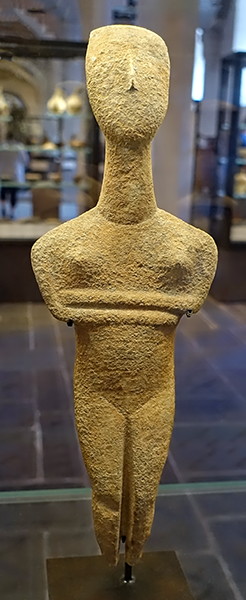
Cycladic female figurine from Paros
Ancient Cycladic II, 2 700 BC - 2 300 BC, Syros Group, Spedos Type, marble
Height: 393 mm.
Catalog: Ma 2708
Photo: Don Hitchcock 2018
Source & text: Original, Musée du Louvre
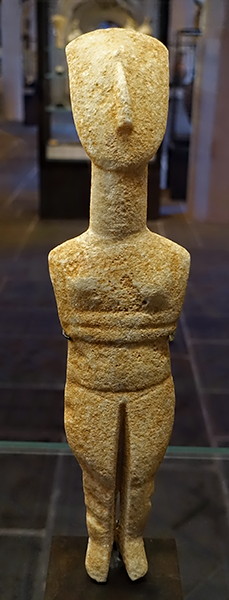
Cycladic female figurine, from Paros
Ancient Cycladic II, 2 700 BC - 2 300 BC, Syros Group, Spedos Type, marble.
Catalog: Ma 2707
Photo: Don Hitchcock 2018
Source & text: Original, Musée du Louvre
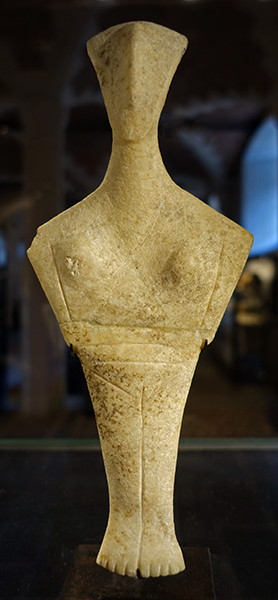
Female figure, Syros Group, Chalandriani type.
Naxos, Ancient Cycladic II, 2 700 BC - 2 300 BC, marble
Height: 275 mm.
This figurine is an elegant illustration of the Chalandriani type, which differs from the Spedo type in displaying a geometric stylisation based on the triangle. It is attributed to the 'Stafford master', whose work is characterised by the large symmetrical arcs described by the lines running from the top of the head to the tips of the shoulders, and by long noses and very slender, straight profiles.
Catalog: Ma 3093
Photo: Don Hitchcock 2018
Source and text: Original, Musée du Louvre
Additional text: http://cartelfr.louvre.fr

Female figure, Syros Group, Chalandriani type.
Ancient Cycladic II, 2 700 BC - 2 300 BC, marble
Catalog: Ma 5003
Photo: Don Hitchcock 2018
Source & text: Original, Musée du Louvre

Female figure, Syros Group, Chalandriani type.
Ancient Cycladic II, 2 700 BC - 2 300 BC, marble
Catalog: Ma 5007
Photo: Don Hitchcock 2018
Source & text: Original, Musée du Louvre

Female figure, Syros Group, Chalandriani type.
Ancient Cycladic II, 2 700 BC - 2 300 BC, marble
Catalog: Ma 5004
Photo: Don Hitchcock 2018
Source & text: Original, Musée du Louvre
Additional text: http://cartelfr.louvre.fr
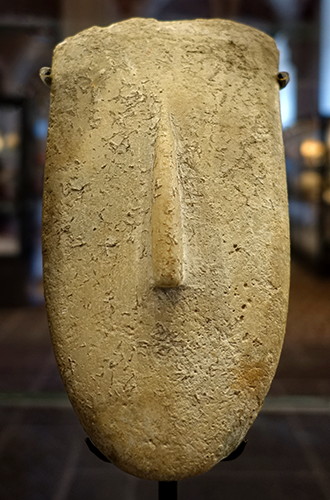
Head of figurine.
Ancient Cycladic II, 2 700 BC - 2 300 BC, marble
Syros Group, Spedos type.
Height 180 mm.
Catalog: Ma 4842
Photo: Don Hitchcock 2018
Source & text: Original, Musée du Louvre
Additional text: http://cartelfr.louvre.fr
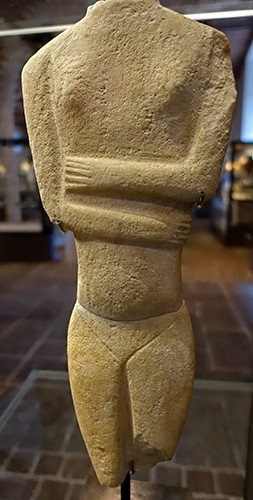
Torso of female figurine.
Ancient Cycladic II, 2 700 BC - 2 300 BC, marble
Syros Group, Spedos type.
Height 352 mm.
Catalog: Ma 5012
Photo: Don Hitchcock 2018
Source & text: Original, Musée du Louvre
Additional text: http://cartelfr.louvre.fr

Figurine
Ancient Cycladic II (?), 2 700 BC - 2 300 BC, marble
Keros-Syros culture
Height: 238 mm.
Catalog: Ma 5008
Photo: Don Hitchcock 2018
Source & text: Original, Musée du Louvre
Additional text: http://cartelfr.louvre.fr

Schematic figurine
Beginning of the Ancient Cycladic II, circa 2 750 BC, marble
The figurine belongs to the Apeiranthos type, named after a village in Naxos. The Apeiranthos type is a development of the spade type of the Early Cycladic I period (3 200 BC - 2 800 BC), but differs in that the head is outlined both in frontal view and in profile and the figurine is not completely flat. In some cases the head is tilted back, while the torso can take various shapes, such as rectangular, rhomboid, triangular etc. Apart from marble, Apeiranthos type figurines were also made of shell.
Height 84 mm.
Catalog: Ma 4988
Photo: Don Hitchcock 2018
Source & text: Original, Musée du Louvre
Additional text: http://cartelfr.louvre.fr, https://cycladic.gr/en/exhibit/ng0352-schimatiko-idolio?cat=kikladiki-techni
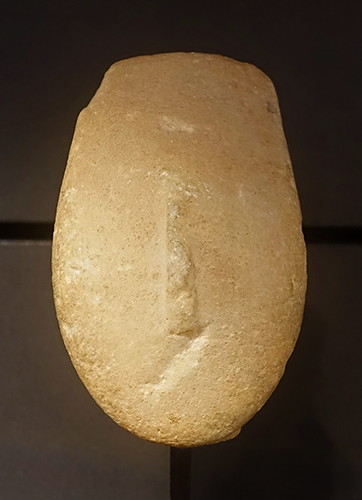
Head of a figurine
Ancient Cycladic II, 2 700 BC - 2 300 BC, marble
Syros culture, Spedos type.
Height 85 mm
Catalog: Ma 5002
Photo: Don Hitchcock 2018
Source & text: Original, Musée du Louvre
Additional text: http://cartelfr.louvre.fr
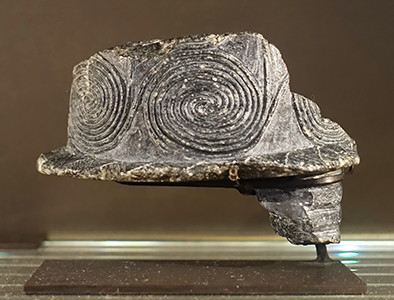
Fragment of a Pyxis
Beginning of Early Ancient Cycladic II, 2 700 BC - 2 300 BC, steatite
(A Pyxis is a box for personal possessions such as cosmetics)
Height 62 mm, width 88 mm.
Catalog: Ma 3564
Photo: Don Hitchcock 2018
Source & text: Original, Musée du Louvre
Additional text: http://cartelfr.louvre.fr

Footed Bowl
Ancient Cycladic II, 2 700 BC - 2 300 BC, marble.
Height 52 mm.
Catalog: Ma 5026
Photo: Don Hitchcock 2018
Source & text: Original, Musée du Louvre
Additional text: http://cartelfr.louvre.fr
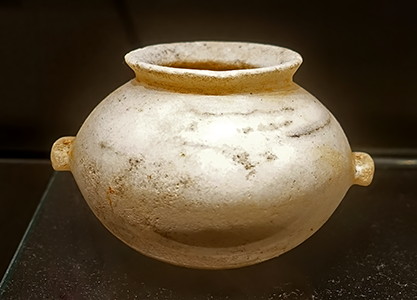
Spherical Pyxis
Ancient Cycladic II, 2 700 BC - 2 300 BC, marble.
Height 85 mm. ( note that a lid exists for this Pyxis, and the height given may include the lid and its handle - Don )
Catalog: Ma 4841
Photo: Don Hitchcock 2018
Source & text: Original, Musée du Louvre
Additional text: http://cartelfr.louvre.fr
Footed Bowl
Ancient Cycladic II, 2 700 BC - 2 300 BC, marble.
Height 54 mm, width 92 mm
Catalog: Ma 4531
Photo: Don Hitchcock 2018
Source & text: Original, Musée du Louvre
Additional text: http://cartelfr.louvre.fr
Palette, Ios.
Ancient Cycladic II, 2 700 BC - 2 300 BC, marble.
Length 177 mm.
Catalog: Ma 3545 c
Photo: Don Hitchcock 2018
Source & text: Original, Musée du Louvre
Additional text: http://cartelfr.louvre.fr
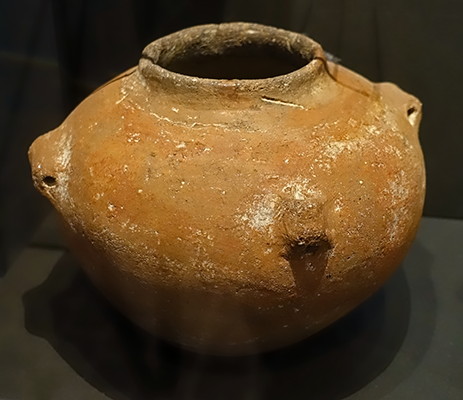
Spherical Pyxis
Heraklion (?) Ancient Cycladic II, 2 700 BC - 2 300 BC, terra cotta.
Height 158 mm, diameter 196 mm.
Catalog: MNE 995
Photo: Don Hitchcock 2018
Source and text: Original, Musée du Louvre
Additional text: http://cartelfr.louvre.fr

Vase with a wide mouth.
Ancient Cycladic II - III, circa 2 300 BC, terra cotta.
Height 173 mm, diameter 161 mm.
Catalog: MNE 996
Photo: Don Hitchcock 2018
Source and text: Original, Musée du Louvre
Additional text: http://cartelfr.louvre.fr
Bowls
Ancient Cycladic II, 2 700 BC - 2 300 BC, marble.
(left) , Ios, Height 134 mm.
(right) Diameter 109 mm., height 33 mm.
Catalog: (left) Ma 3545 a, (right) Ma 5024
Photo: Don Hitchcock 2018
Source and text: Original, Musée du Louvre
Additional text: http://cartelfr.louvre.fr

Kernos, from Melos, terra cotta.
Ancient Cycladic III, 2 000 BC
Height 190 mm, diameter 303 mm.
Found mainly in tombs, this type of vase was perhaps used for funerary rituals. In the typology of ancient Greek pottery, the kernos is a pottery ring or stone tray to which are attached several small vessels for holding offerings. Its unusual design is described in literary sources, which also list the ritual ingredients it might contain. The kernos was used primarily in the cults of Demeter and Kore, and of Cybele and Attis.
The form begins in the Neolithic in stone, in the earliest stages of the Minoan civilisation, around 3 000 BC. They were produced in Minoan and Cycladic pottery, being the most elaborate shape in the latter, and right through ancient Greek pottery.
Catalog: Sèvres 3552
Photo: Don Hitchcock 2018
Source and text: Original, Musée du Louvre
Additional text: http://cartelfr.louvre.fr, Wikipedia
Figurines of the 'Plastiras type', named after the cemetery on Paros where they were first identified, were contemporary with violin-shaped figurines and represent the earliest attempt at the naturalistic rendering of the human figure in the third millennium BC. These figurines, which are mainly female and of small dimensions (height 7-31 cm), display some of those features that were subsequently to develop into distinctive traits of Cycladic figurines, such as the position of the arms below the breasts and the ovoid head with the nose in relief. However, the sculptors had not yet conquered the abstraction of the mature period of Cycladic art and instead cleaved to a markedly naturalistic conception, which is particularly pronounced in the treatment of the pelvic area, the pubic triangle and the legs. Typologically, the Plastiras type figurines are a development of the steatopygous figures of the Late Neolithic period (5300-3200 BC).Text above: https://artsandculture.google.com/asset/cycladic-female-figurine-plastiras-type/8AFPjlP1XiE1nQ

Female statuette
Ancient Cycladic I, 3 200 BC - 2 700 BC, Plastiras type, marble.
Height: 73 mm
'Plastiras'type figurines are characterised by a degree of naturalism in the rendering of anatomical detail (distinctly pronounced hips and rounded breasts, belly and knees). The hands are joined at the finger-tips, the legs are rendered separately, and the feet are placed flat against the ground.
Catalog: Ma 4987
Photo: Don Hitchcock 2018
Source & text: Original, Musée du Louvre
Additional text: http://cartelfr.louvre.fr
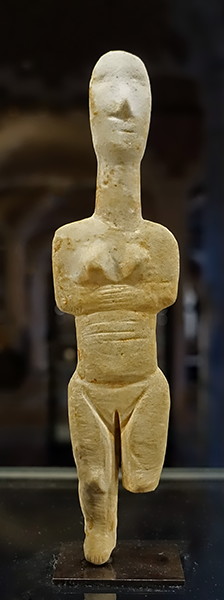
Female figurine, Plastiras type.
Ancient Cycladic I, 3 200 BC - 2 700 BC, Plastiras type, marble.
This figurine is probably unfinished.
( note the interlaced fingers which help to define this figurine as of the Plastiras type - Don )
Height: 200 mm.
Catalog: Ma 3520
Photo: Don Hitchcock 2018
Source & text: Original, Musée du Louvre
Additional text: http://cartelfr.louvre.fr
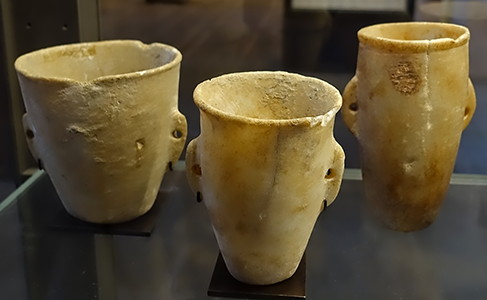
Goblets, Plastiras Group.
Ancient Cycladic I, 3 200 BC - 2 700 BC, marble.
(left) Height 123 mm, diameter 121 mm, Catalog Ma 3507
(centre) Height 120 mm, diameter 81 mm, Catalog Ma 3502
(right) Height 154 mm, diameter 121 mm, Catalog Ma 5019
Photo: Don Hitchcock 2018
Source & text: Original, Musée du Louvre
Additional text: http://cartelfr.louvre.fr
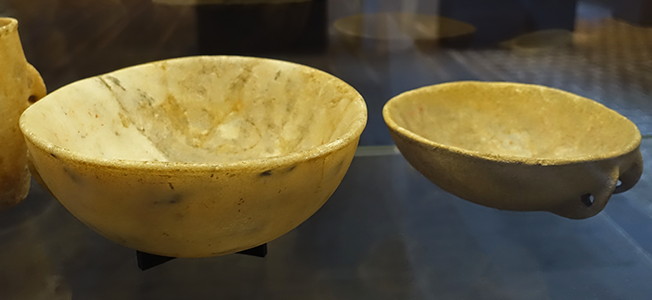
Bowls, Plastiras Group.
Ancient Cycladic I, 3 200 BC - 2 700 BC, marble.
(left) One handled bowl, traces of red pigment.
Diameter 235 mm, Catalog Ma 4838
(right) Two handled bowl, traces of pigments.
Height 76 mm, diameter 202 mm, Catalog Ma 5020
Photo: Don Hitchcock 2018
Source & text: Original, Musée du Louvre
Additional text: http://cartelfr.louvre.fr
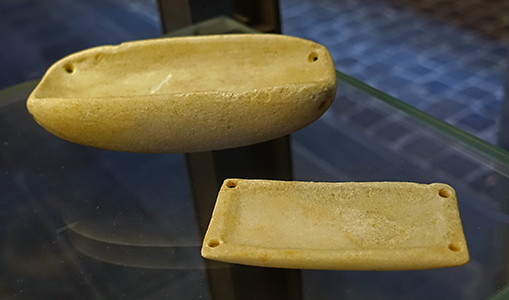
Palettes, Plastiras Group.
Ancient Cycladic I, 3 200 BC - 2 700 BC, marble.
(left, rear) The traces of red colours, as on this palette, Ma 5022, and blue on some similar specimens suggest that these objects could have been used to mix pigments.
Height 45 mm, width 85 mm, length 165 mm, Catalog Ma 5022.
(right, front) Palette, Catalog Ma 5021
Photo: Don Hitchcock 2018
Source & text: Original, Musée du Louvre
Additional text: http://cartelfr.louvre.fr
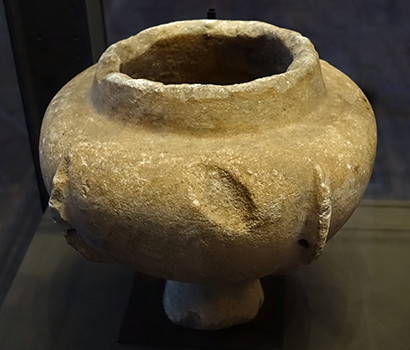
Kandela, Plastiras Group.
Ancient Cycladic I, 3 200 BC - 2 700 BC, marble.
Kandelas, or Kegelhalsgefäß, or cone neck vessels, which were comparatively numerous at this time, usually of marble, can be described as the signature object of the Plastiras group.
Catalog: Ma 4706
Photo: Don Hitchcock 2018
Source & text: Original, Musée du Louvre
Additional text: http://cartelfr.louvre.fr

Kandela, Plastiras Group.
Ancient Cycladic I, 3 200 BC - 2 700 BC, marble..
Height 280 mm, width 280 mm.
This vessel, like similar Kandelas, could be placed on its foot or suspended by cords passing through the perforated vertical lug handles. Its exact use is unknown. It is called a Kandela (candle) because of its shape, resembling a modern lamp. Marble vases of this type were found in tombs with figurines, especially at Plastiras on the island of Paros.
Catalog: Ma 4839
Photo: Don Hitchcock 2018
Source & text: Original, Musée du Louvre
Additional text: http://cartelfr.louvre.fr

Kandela, Plastiras Group.
Ancient Cycladic I, 3 200 BC - 2 700 BC, marble.
Height 136 mm.
Catalog: Ma 5018
Photo: Don Hitchcock 2018
Source & text: Original, Musée du Louvre
Additional text: http://cartelfr.louvre.fr
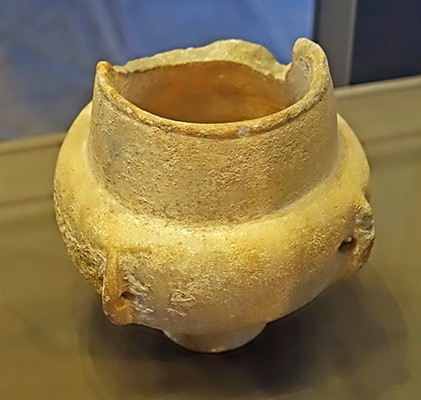
Kandela, Amorgos.
Ancient Cycladic I, 3 200 BC - 2 700 BC, marble.
Height 130 mm, diameter 145 mm.
Catalog: Ma 3096
Photo: Don Hitchcock 2018
Source & text: Original, Musée du Louvre
Additional text: http://cartelfr.louvre.fr
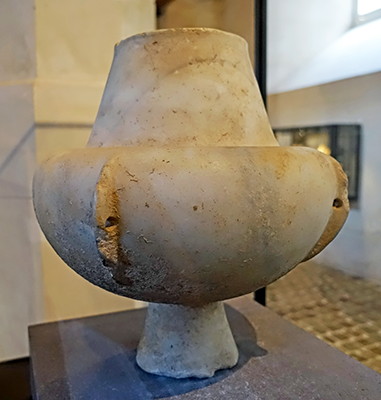
Kandela.
Ancient Cycladic I, 3 200 BC - 2 700 BC, marble.
Height 347 mm.
This type of tripartite vase with foot, belly (in the shape of a sea urchin test) and neck has vertical perforated lugs that could be interpreted as a suspension device. Mostly found in a funerary context, the kandela is associated with naturalistic figurines, of the Plastiras type, figurines whose hands meet at the ends of the fingers, rather than the arms being crossed over the chest or abdomen, as in later figurines.
( this is a particularly finely proportioned and finished specimen - Don )
Catalog: Ma 5017
Photo: Don Hitchcock 2018
Source & text: Original, Musée du Louvre
Additional text: http://cartelfr.louvre.fr

Glass case of Cycladic artefacts.
Cycladic Civilisation, 3 200 BC - 2 300 BC
Photo: Don Hitchcock 2018
Source: Original, Musée du Louvre
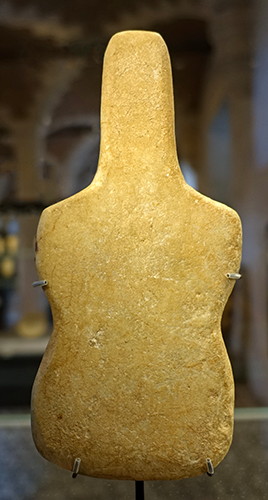
Figurine in the shape of a violin, Pelos Group.
Ancient Cycladic I, 3 200 BC - 2 700 BC, marble.
Height: 188 mm.
Catalog: Ma 4993
Photo: Don Hitchcock 2018
Source & text: Original, Musée du Louvre
Additional text: http://cartelfr.louvre.fr
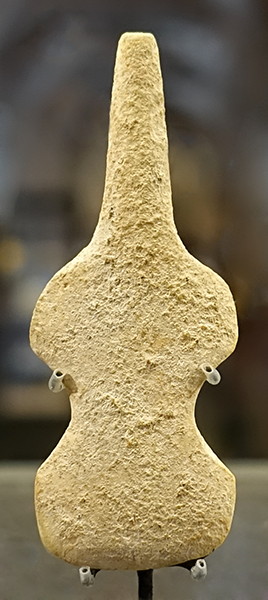
Figurine in the shape of a violin, Pelos Group.
Ancient Cycladic I, 3 200 BC - 2 700 BC, marble.
Catalog: Ma 4986
Photo: Don Hitchcock 2018
Source & text: Original, Musée du Louvre
Additional text: http://cartelfr.louvre.fr
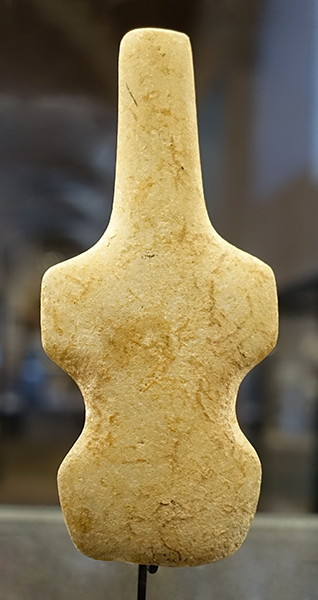
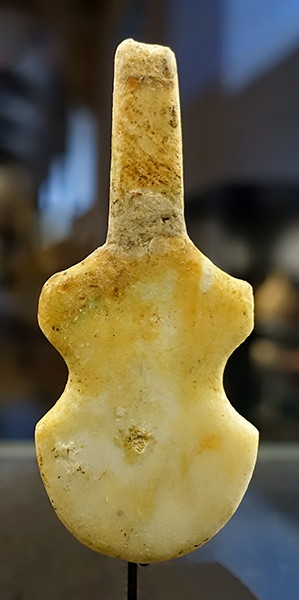
Figurines in the shape of a violin, Pelos Group.
Ancient Cycladic I, 3 200 BC - 2 700 BC, marble.
Catalog: (left) Ma 3505, (right) Ma 3508
Photo: Don Hitchcock 2018
Source & text: Original, Musée du Louvre
Additional text: http://cartelfr.louvre.fr
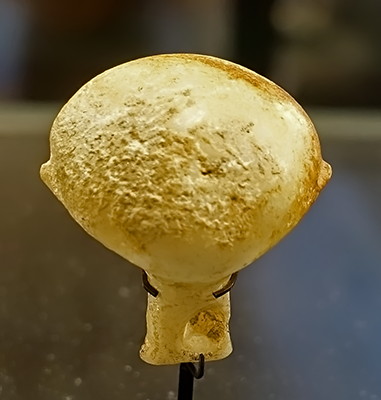
Female statuette head
Ancient Bronze I - II, 3 200 BC - 2 300 BC, marble.
Provenance: Clazomenes
The Kiliya Type, from Western Anatolia, is characterised by an oval head where the nose and ears are plastically noted, and a small body shaped like a willow leaf.
Height 40 mm.
The perforation of the neck is probably due to an ancient reuse.
Catalog: Ma 4549
Photo: Don Hitchcock 2018
Source & text: Original, Musée du Louvre
Additional text: http://cartelfr.louvre.fr
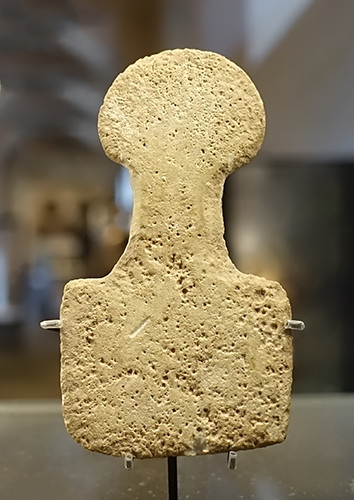
Schematic figurine
Ancient Bronze II, 2 700 BC - 2 300 BC, marble.
Kusura type, western Anatolia
Height 82 mm.
Schematic figurine from western Anatolia, representing the human figure in a highly abstract way. It belongs to the so-called 'Kusura' type and is strongly reminiscent of Cycladic schematic figurines (especially the spade- and violin-shaped ones) not only because of its material but also because of the flat profile and the overall shape.
During the Early Bronze Age, marble was used extensively for the manufacture of figurines of flat profile not only in the Aegean but all over the eastern Mediterranean.
Catalog: Ma 5016
Photo: Don Hitchcock 2018
Source & text: Original, Musée du Louvre
Additional text: http://cartelfr.louvre.fr, https://cycladic.gr/en/exhibit/ng0961-schimatiko-idolio-tipou-kusura
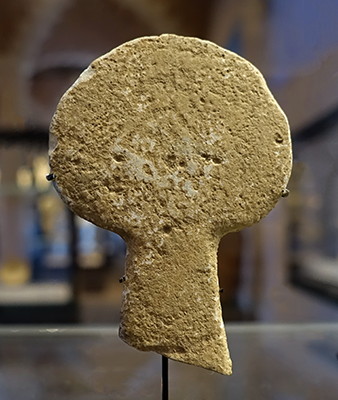
Schematic figurine, head, Kusura type, western Anatolia.
Ancient Bronze II, 2 700 BC - 2 300 BC, marble.
The Kusura type consists of a very schematic representation of the human figure with a disc-shaped head resting on a long neck and a body represented by a simple rectangle.
Catalog: Ma 3269 f
Photo: Don Hitchcock 2018
Source & text: Original, Musée du Louvre
Additional text: http://cartelfr.louvre.fr
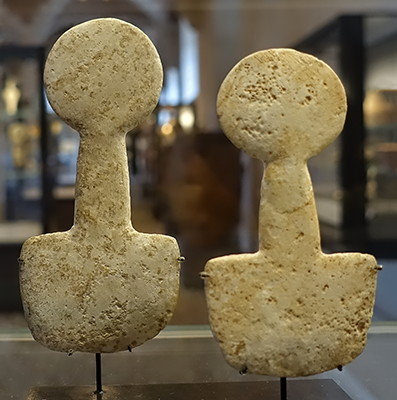
Schematic figurines, Lebedos
Ancient Bronze II, 2 700 BC - 2 300 BC, marble.
Kusura type, western Anatolia.
The Kusura type consists of a very schematic representation of the human figure with a disc-shaped head resting on a long neck and a body represented by a simple rectangle.
Catalog:
Left: Ma 3269 c
Right: Ma 3269 b
Photo: Don Hitchcock 2018
Source & text: Original, Musée du Louvre
Additional text: http://cartelfr.louvre.fr
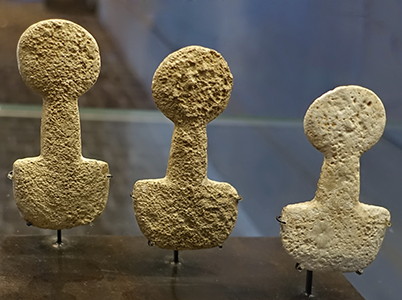
Schematic figurines, Lebedos
Ancient Bronze II, 2 700 BC - 2 300 BC, marble.
Kusura type, western Anatolia
The Kusura type consists of a very schematic representation of the human figure with a disc-shaped head resting on a long neck and a body represented by a simple rectangle.
Catalog:
Left: Ma 3269 e
Centre: Ma 3269 d
Right: Ma 3269 a
Photo: Don Hitchcock 2018
Source & text: Original, Musée du Louvre
Additional text: http://cartelfr.louvre.fr
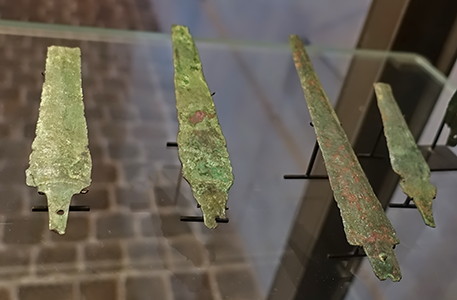
Dagger blades, Lebedos
Ancient Bronze II, 2 700 BC - 2 300 BC, Copper alloy.
These blades were fixed by rivets to handles of perishable material (wood or bone). The item Br 1455 has retained its rivet. This set came from the same grave as the figures Ma 3269 f, Ma 3269 c, Ma 3269 b, Ma 3269 e, Ma 3269 d, Ma 3269 a.
Catalog:
Left: possibly one of Br 1456, Br 1457
Left centre: Br 1454
Right centre: Br 1453, length 175 mm.
Right: Br 1455
Photo: Don Hitchcock 2018
Source & text: Original, Musée du Louvre
Additional text: http://cartelfr.louvre.fr
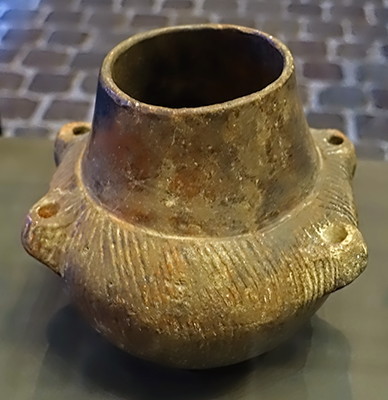
Kandela, Heraklion (Crete) ?
Ancient Cycladic I, 3 200 BC - 2 700 BC, terra cotta.
Height 162 mm, width 186 mm.
Catalog: MNE 994
Photo: Don Hitchcock 2018
Source & text: Original, Musée du Louvre
Additional text: http://cartelfr.louvre.fr
(Left) Cylindrical Pyxis.
(Right) Cylindrical Pyxis with incised decoration.
Ancient Cycladic I, 3 200 BC - 2 700 BC, Pelos group, terra cotta.
Height 75 mm, width 130 mm, diameter 112 mm.
Catalog: CA 6989
Photo: Don Hitchcock 2018
Source & text: Original, Musée du Louvre
Additional text: http://cartelfr.louvre.fr
References
- Horst K., Schulze H., Steinmann B., 2015: Kykladen, Frühe Kunst in der Ägäis, Kykladen, Frühe Kunst in der Ägäis, Edited by Rupert Gebhard - Harald Schulze © 2015 by Archäologische Staatssammlung Munich - Museum for Prehistory and Early History ISBN 978-3-927806-39-9, Accompanying book to the exhibition in the Archäologische Staatssammlung München 13.2.2015 - 7.7. 2015
- Pressekonferenz, 2011: zur großen Sonderausstellung 'Kykladen. Lebenswelten einer frühgriechischen Kultur', Freitag, 16. Dezember, 11 Uhr, Badisches Landesmuseum, Schloss. URL: http://www.landesmuseum.de/website/dyndata/Sammelmappe_Kykladen.pdf
